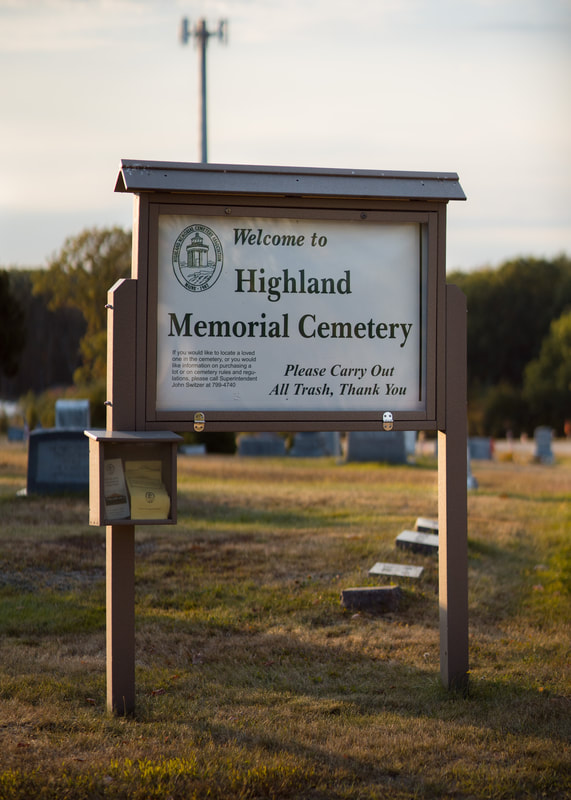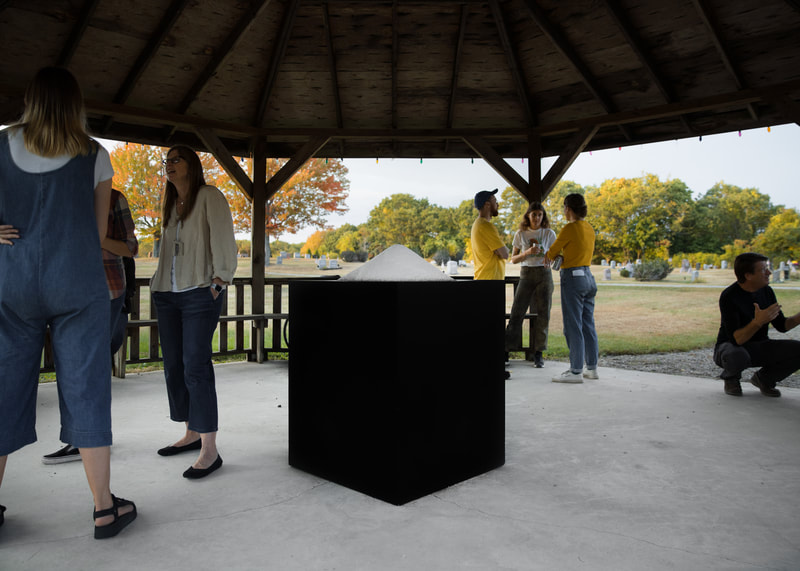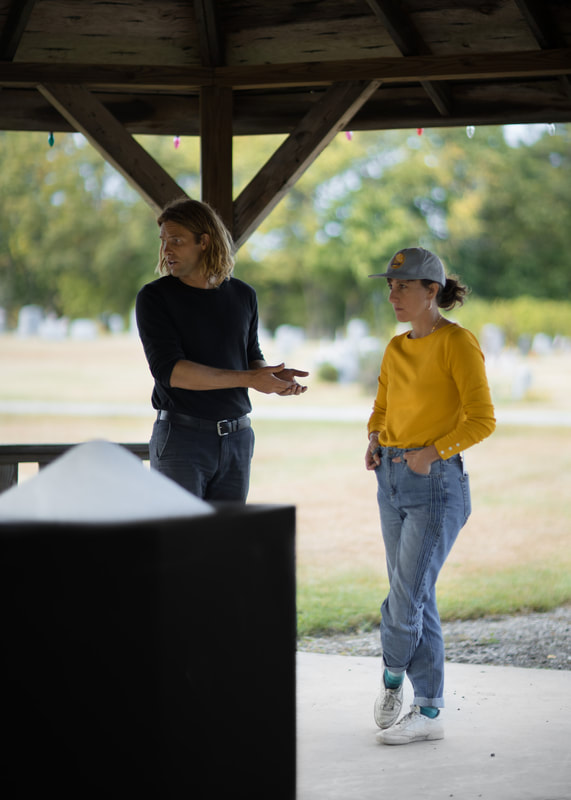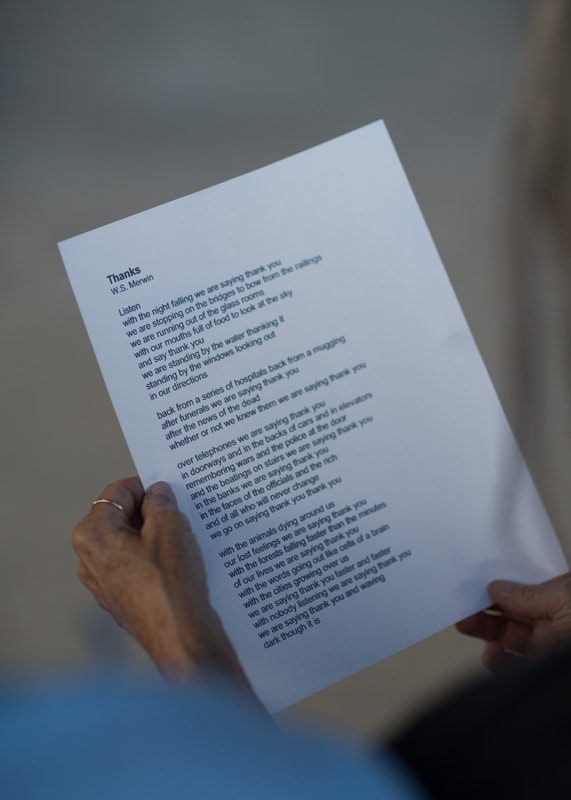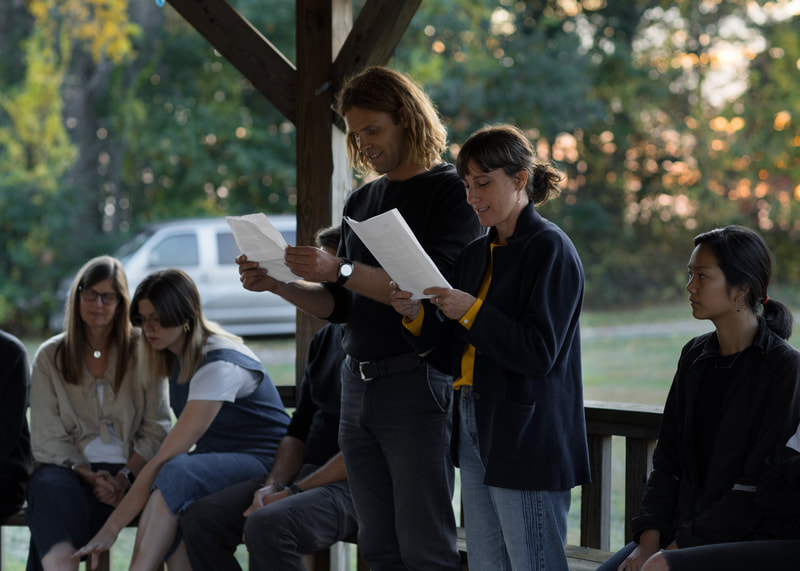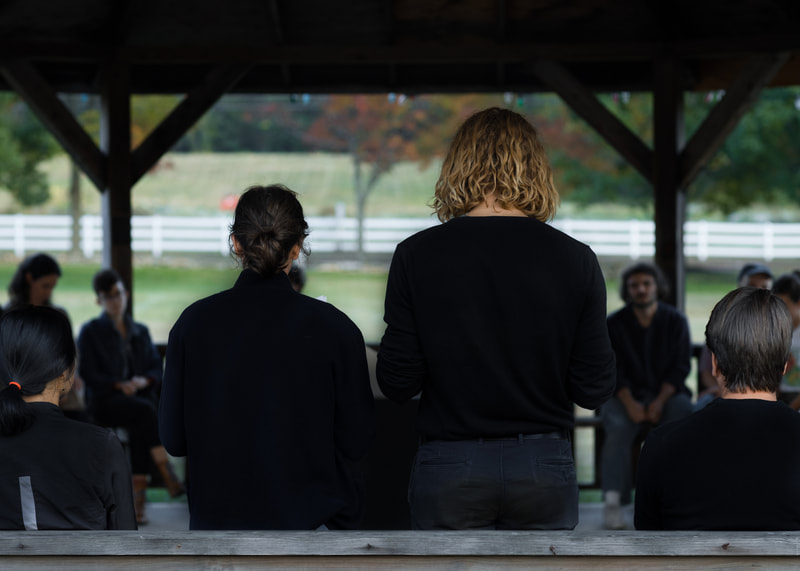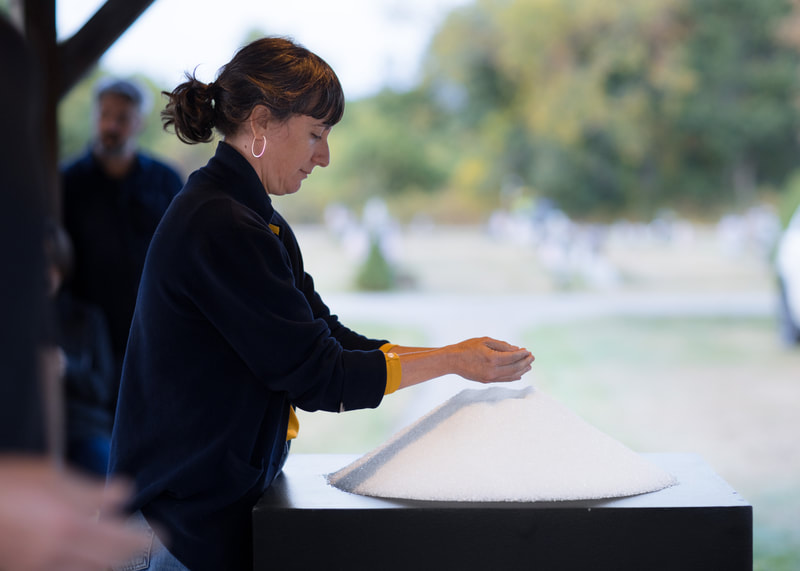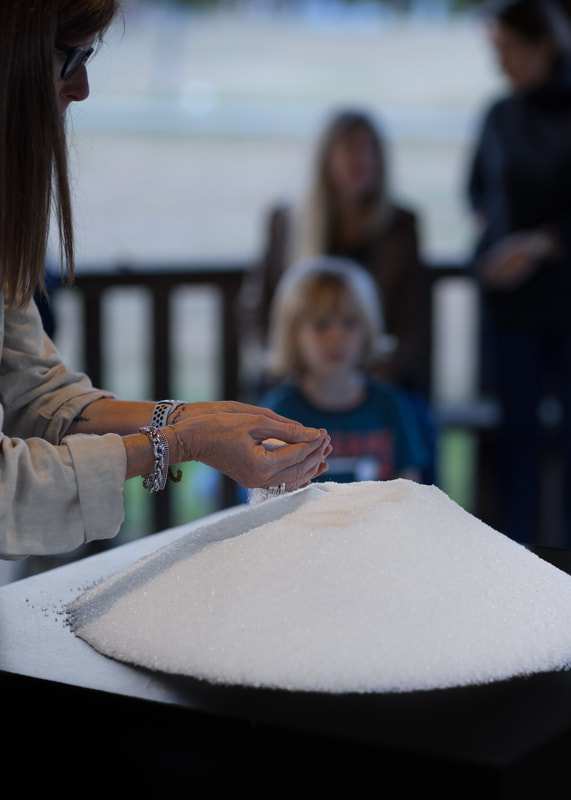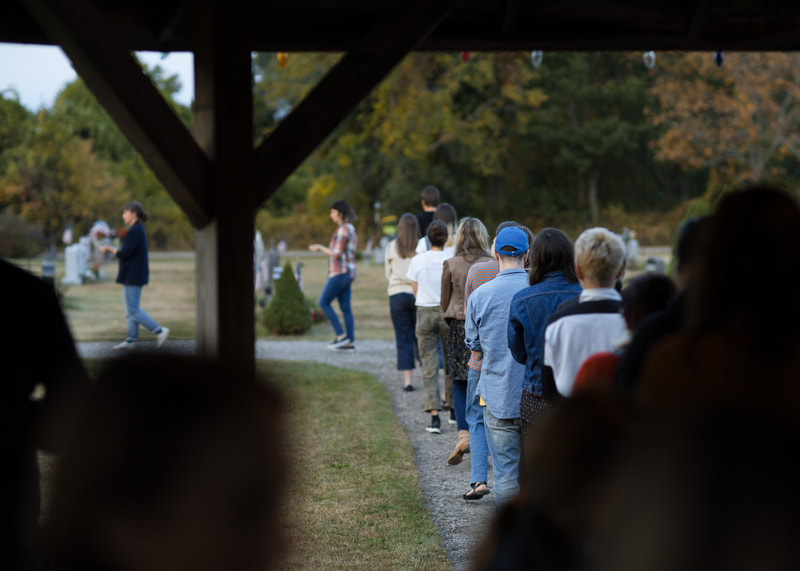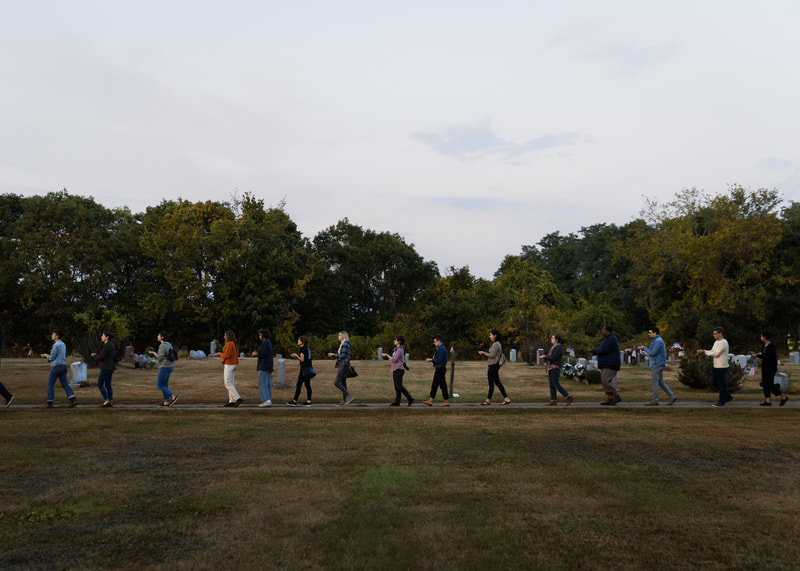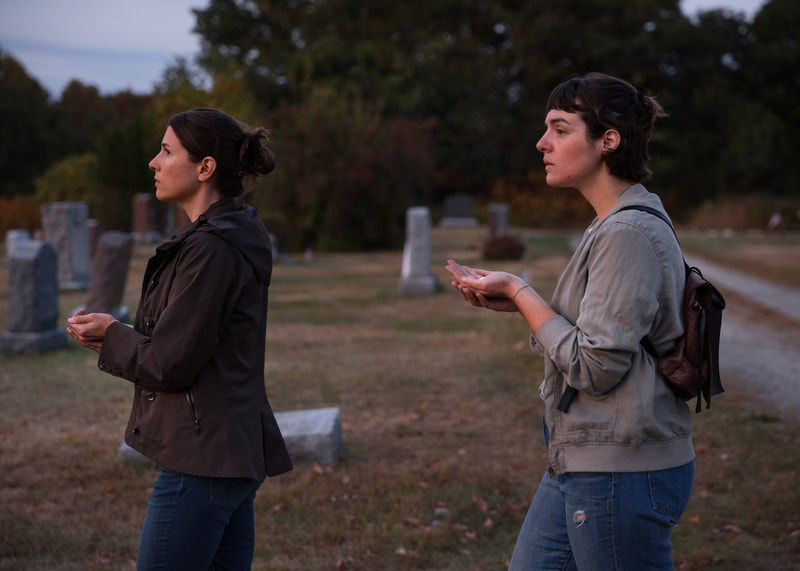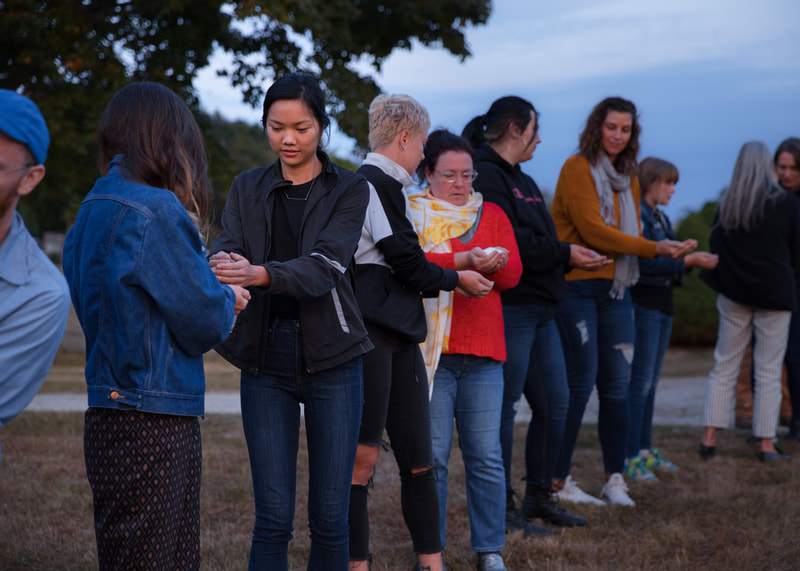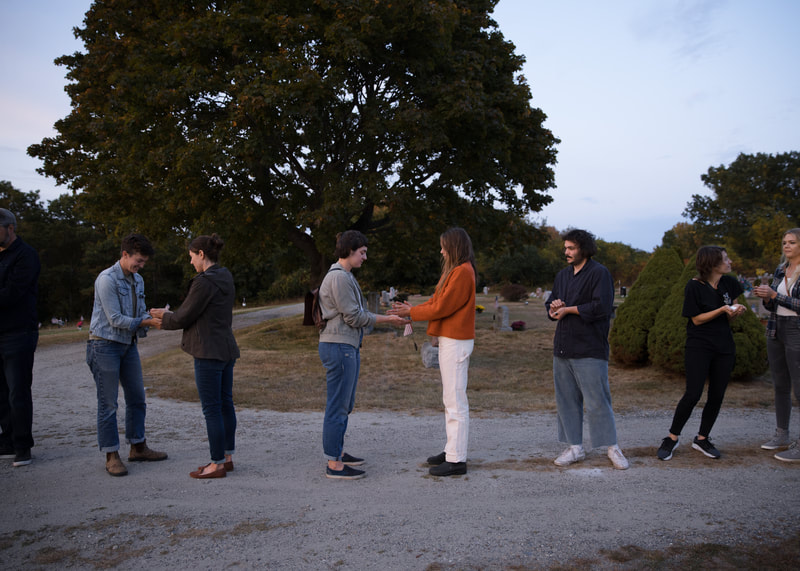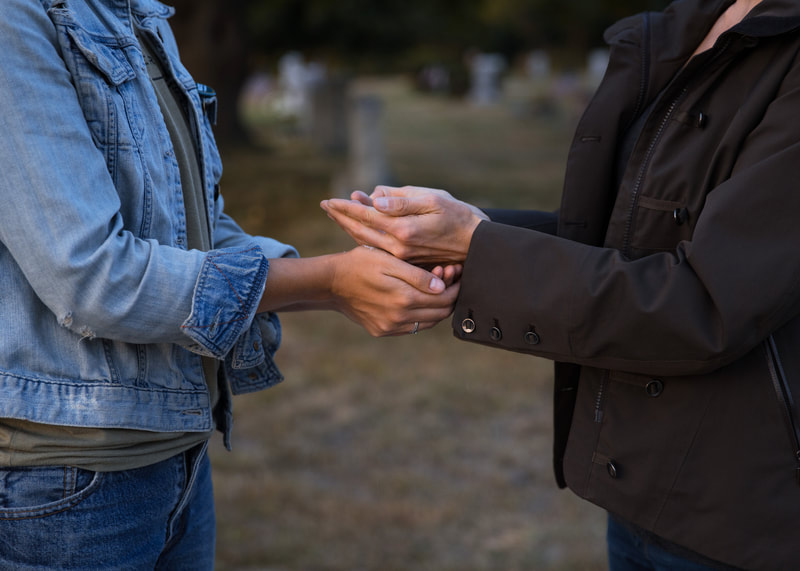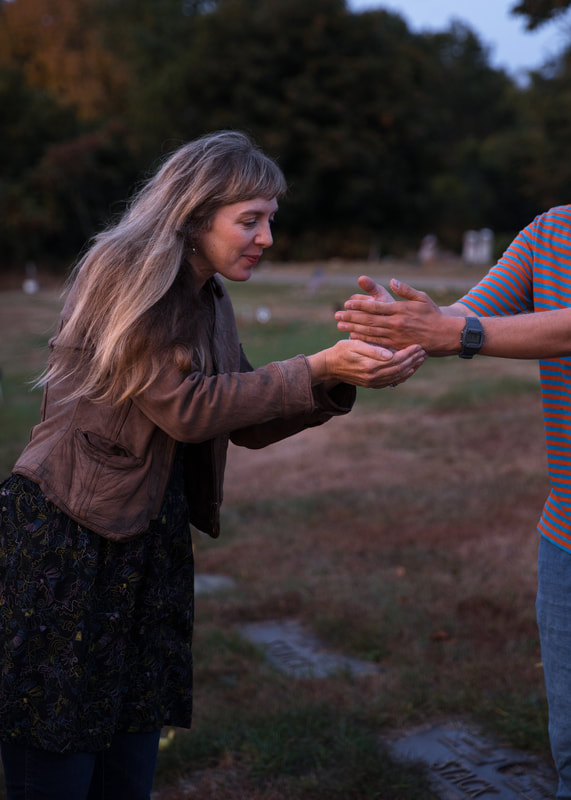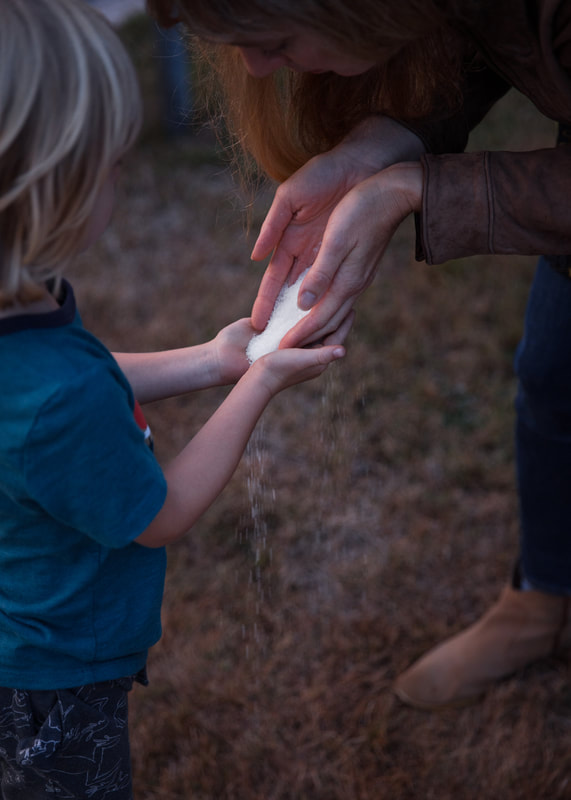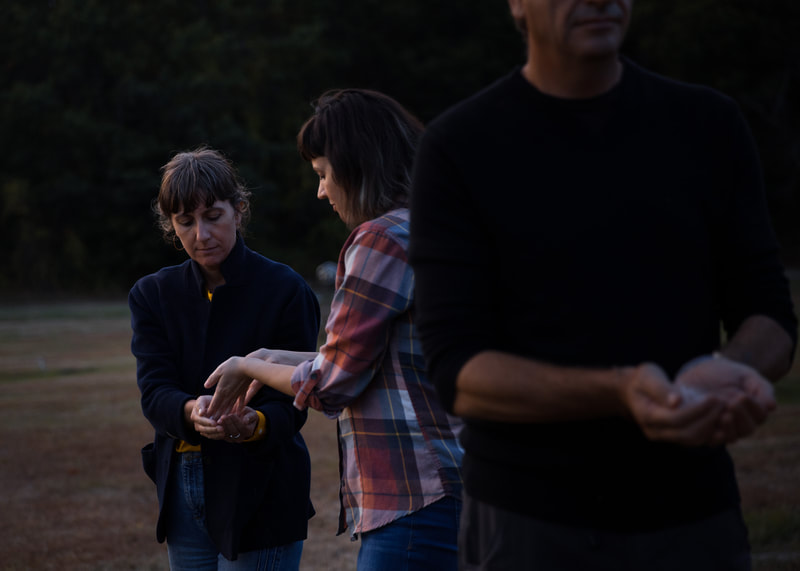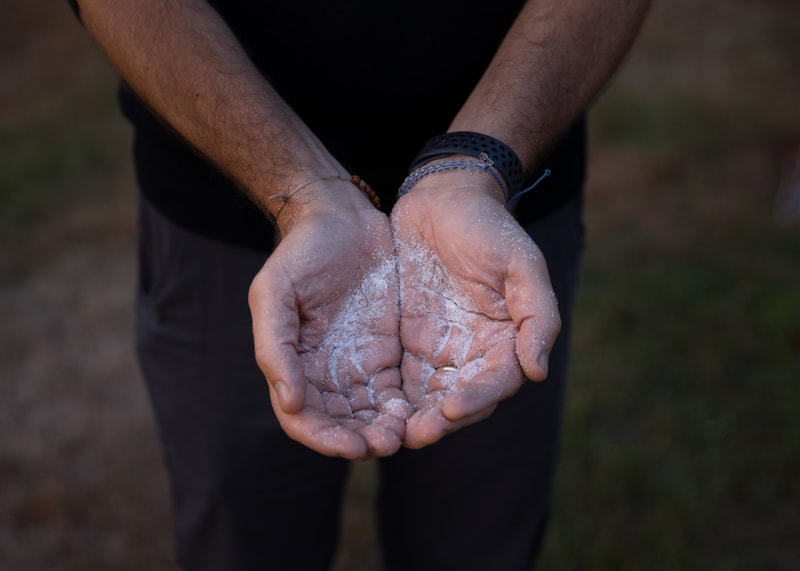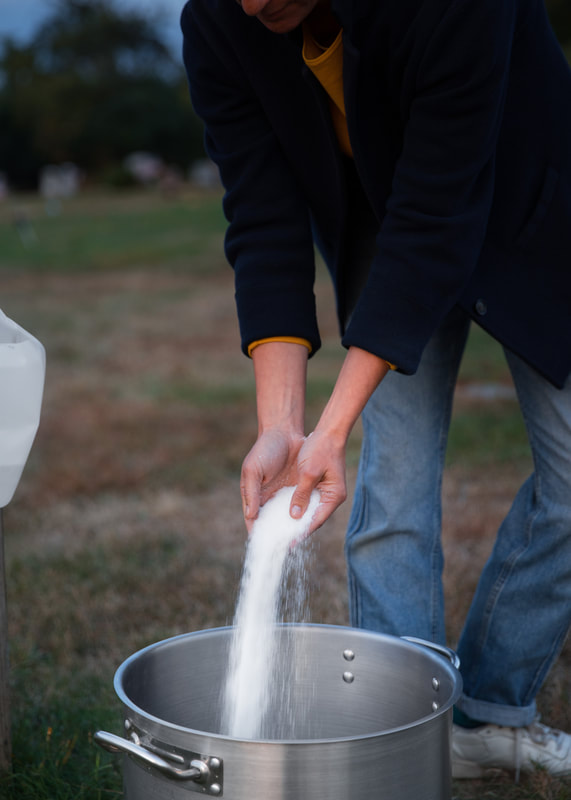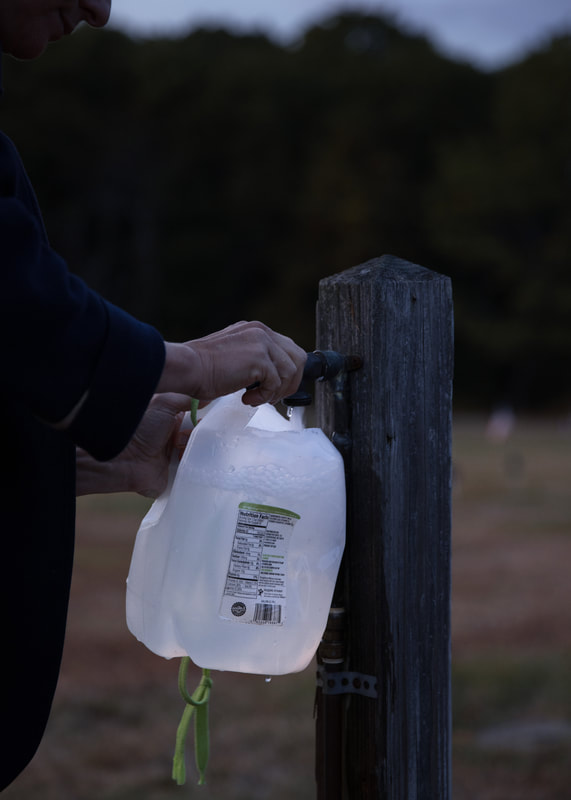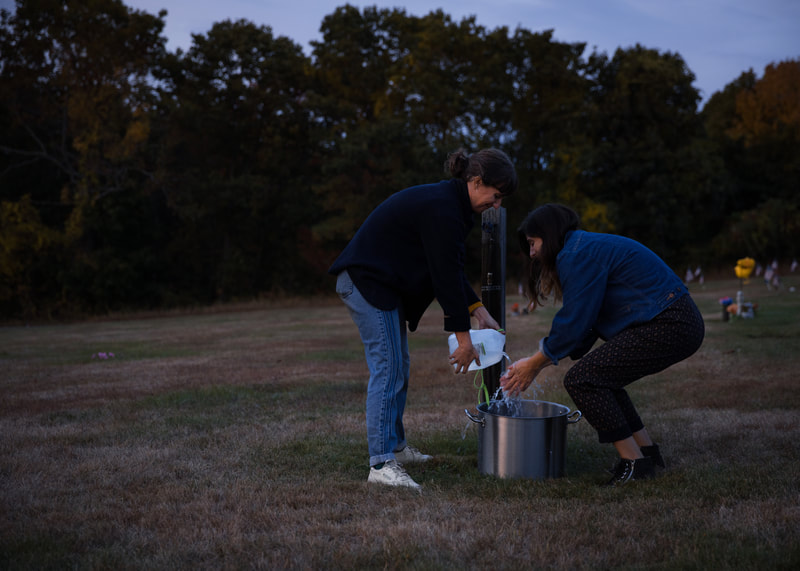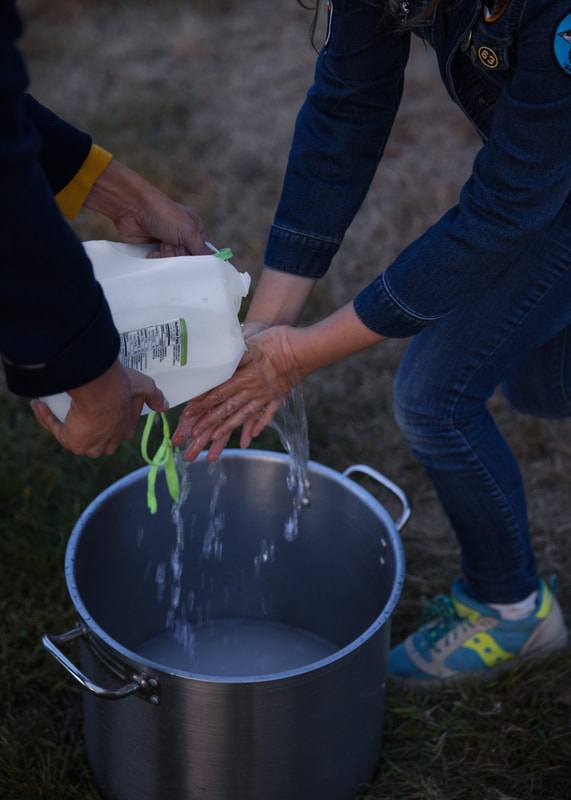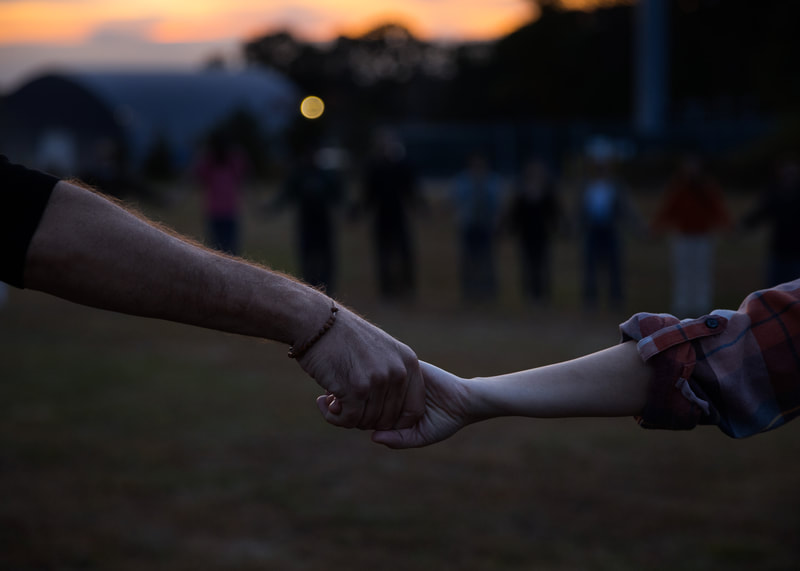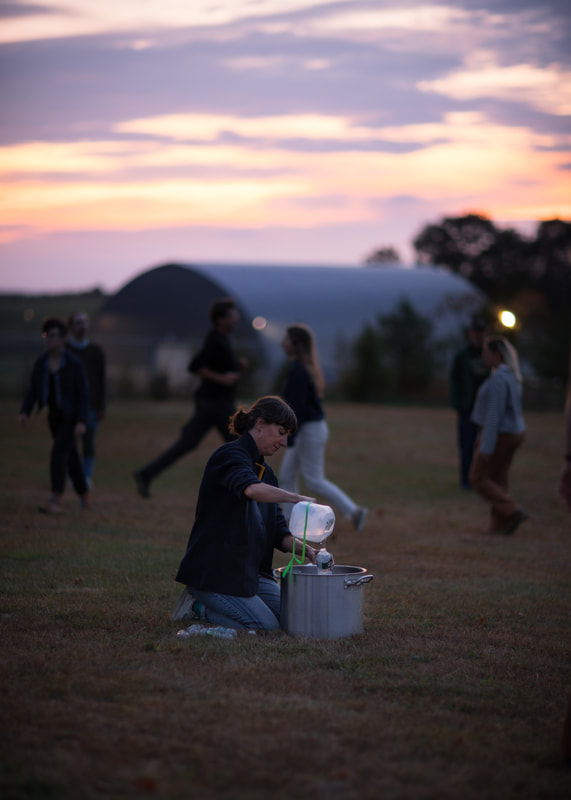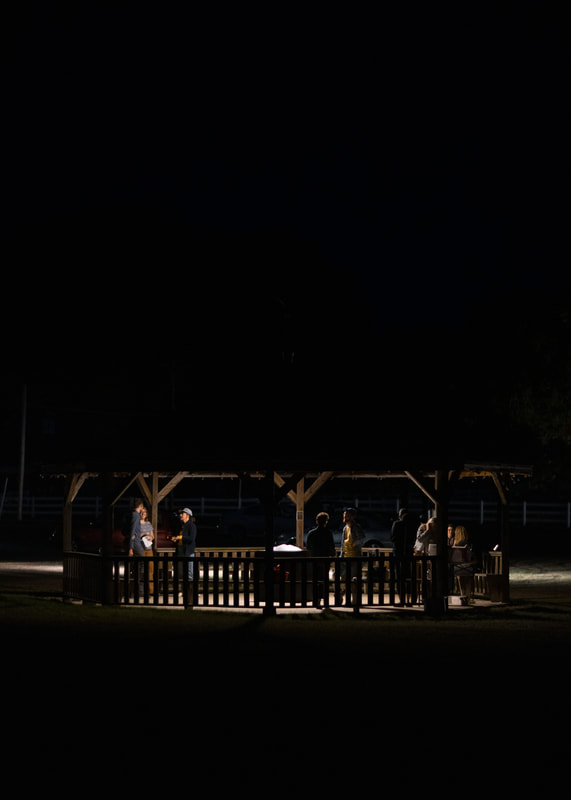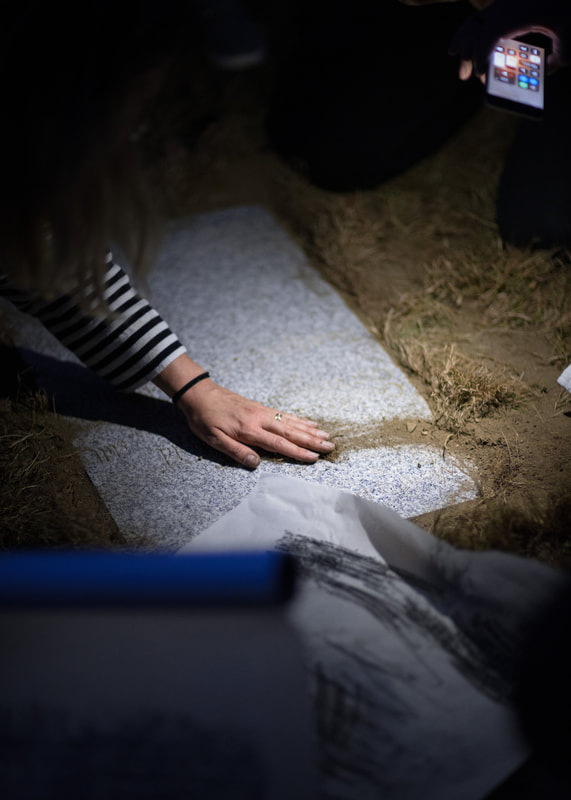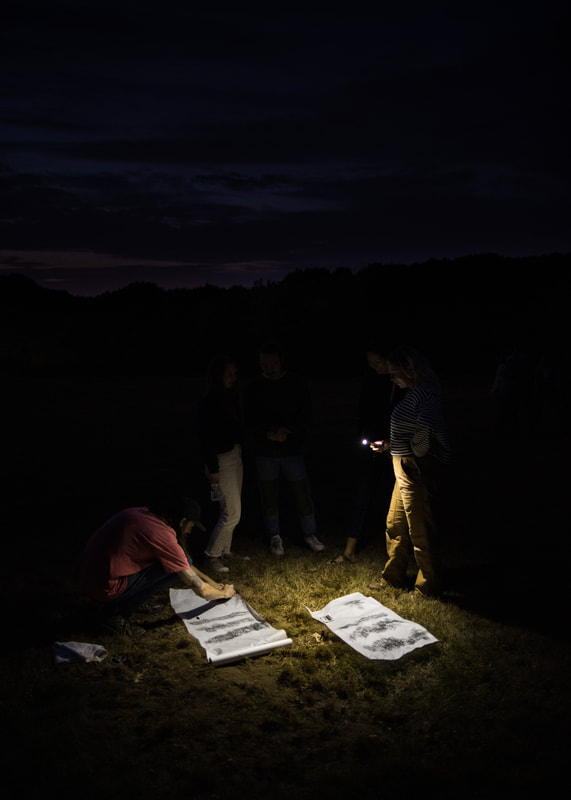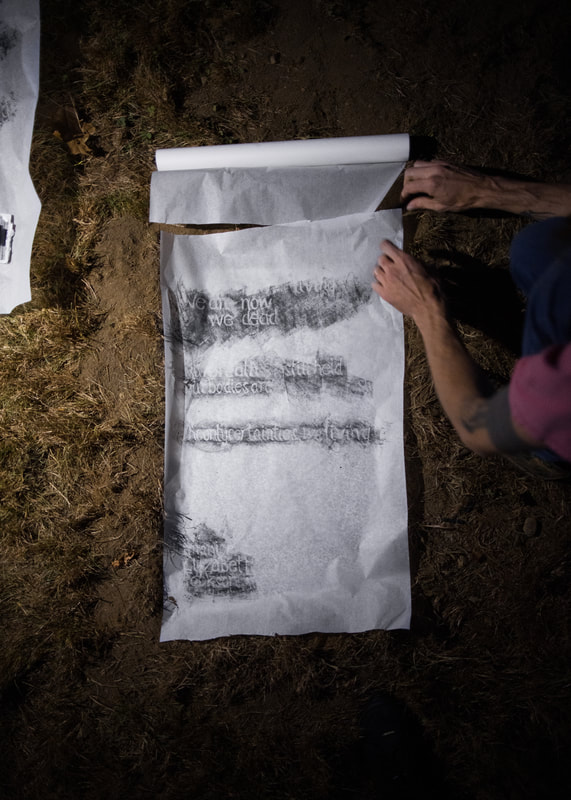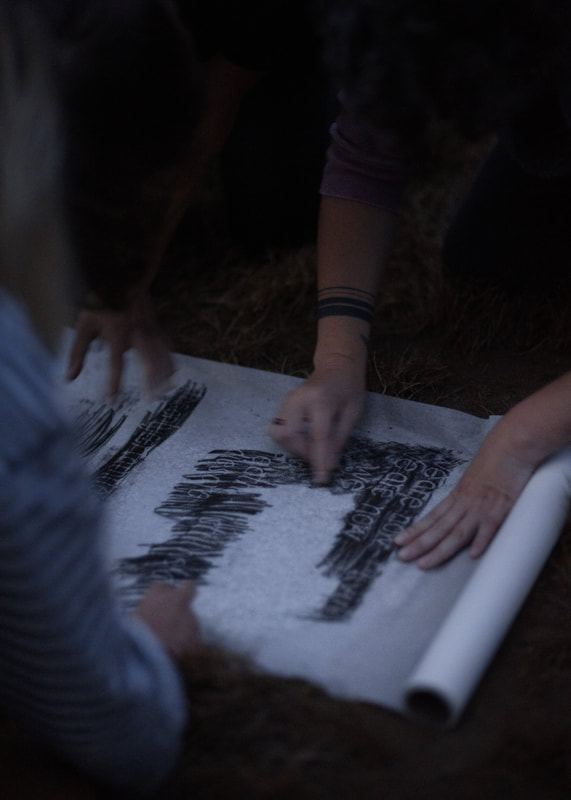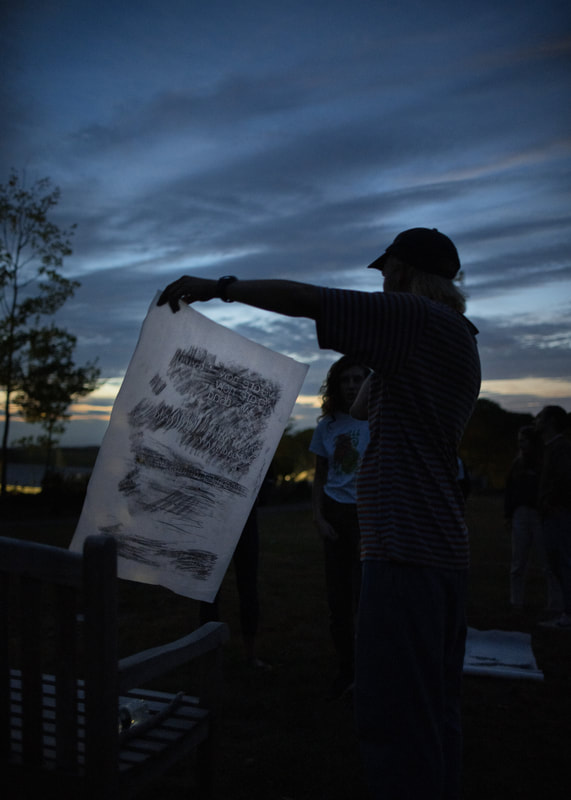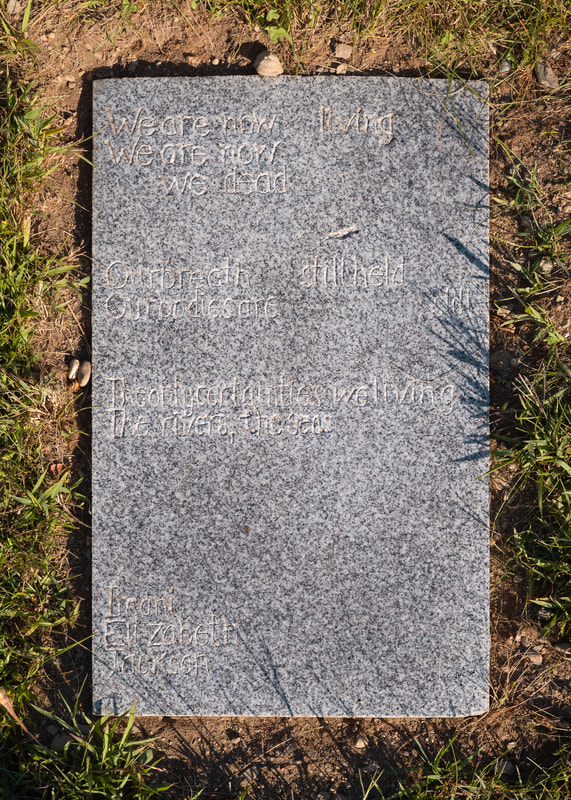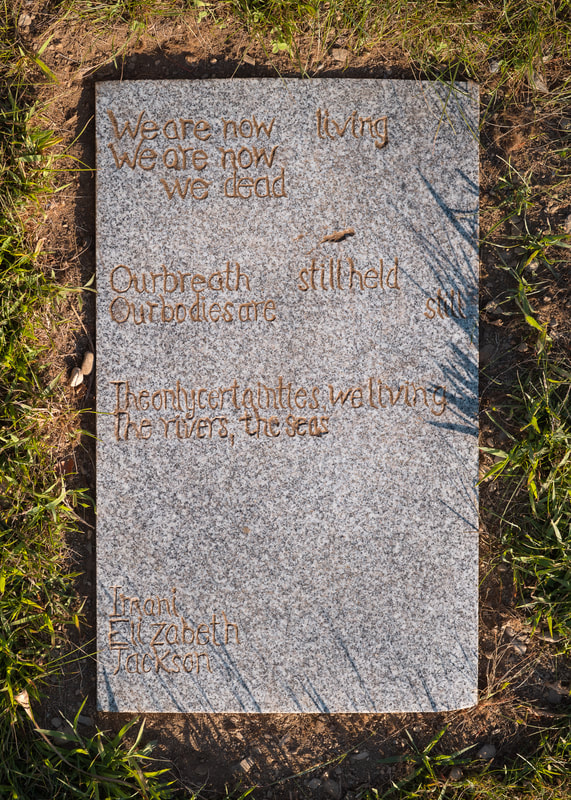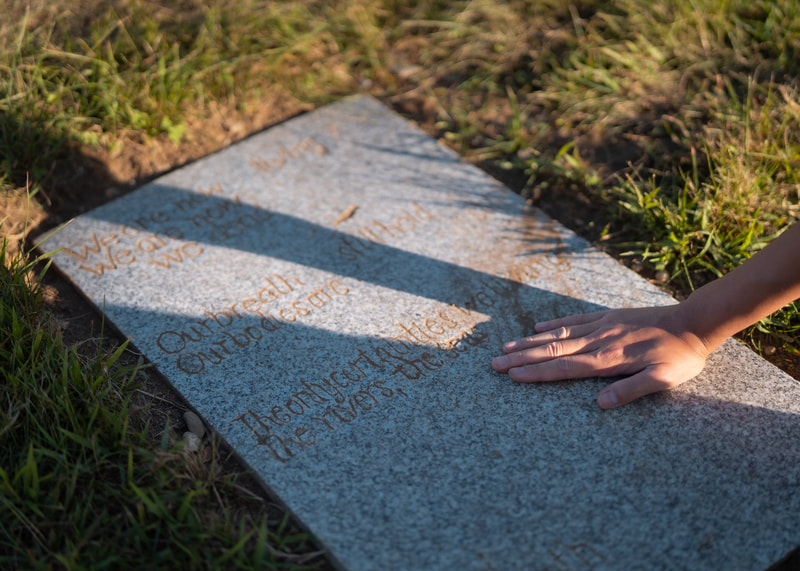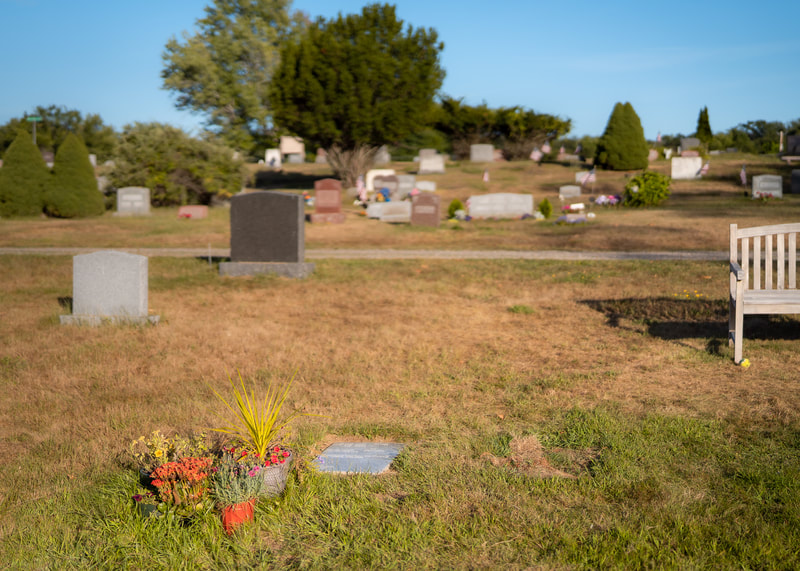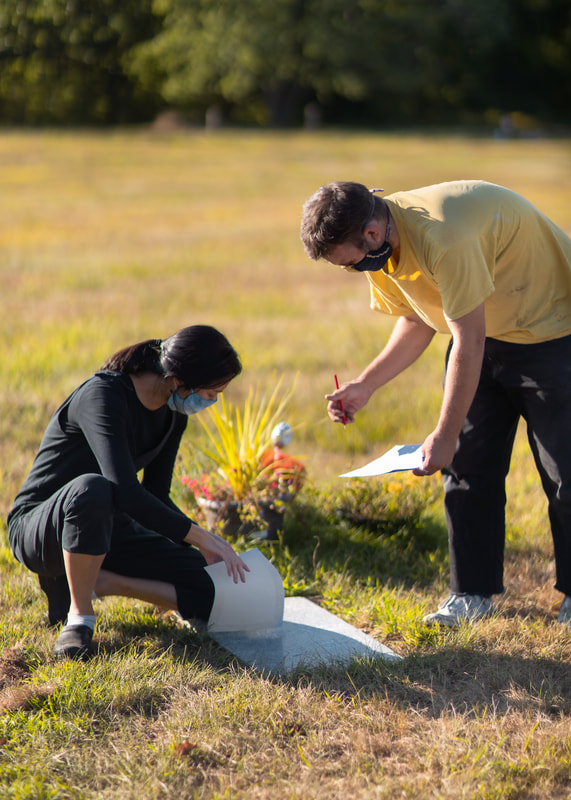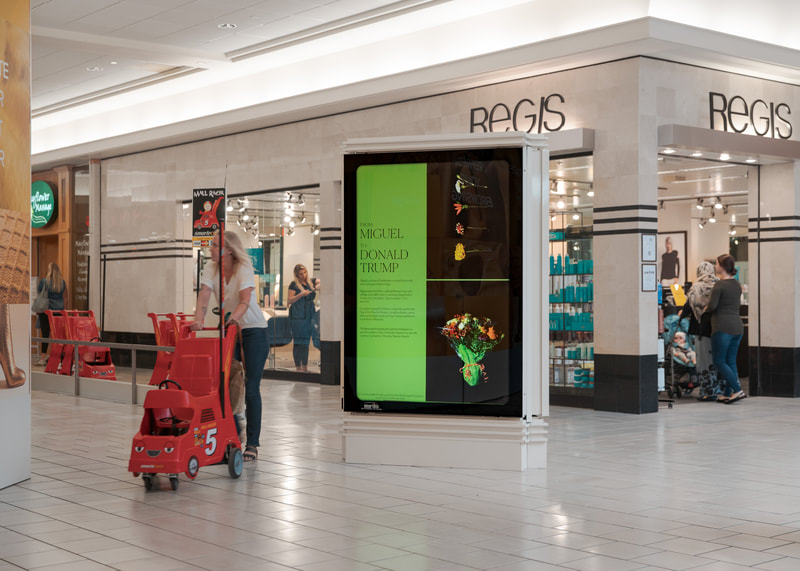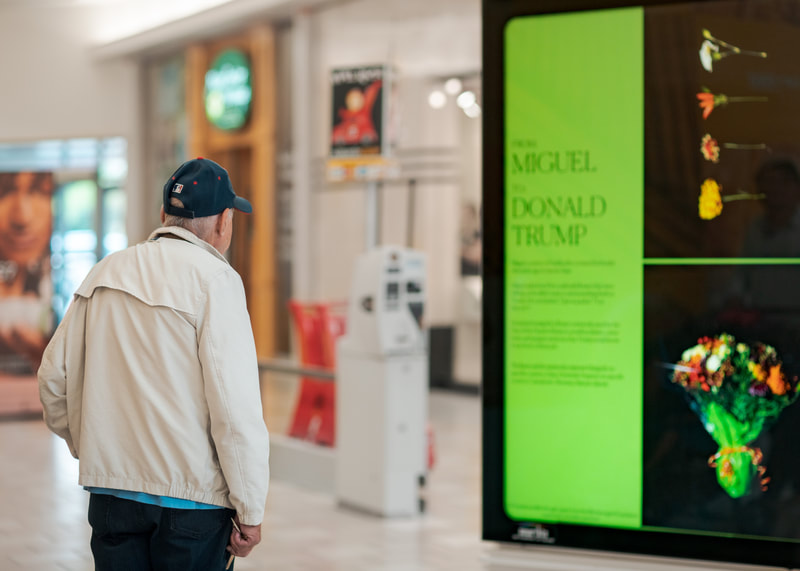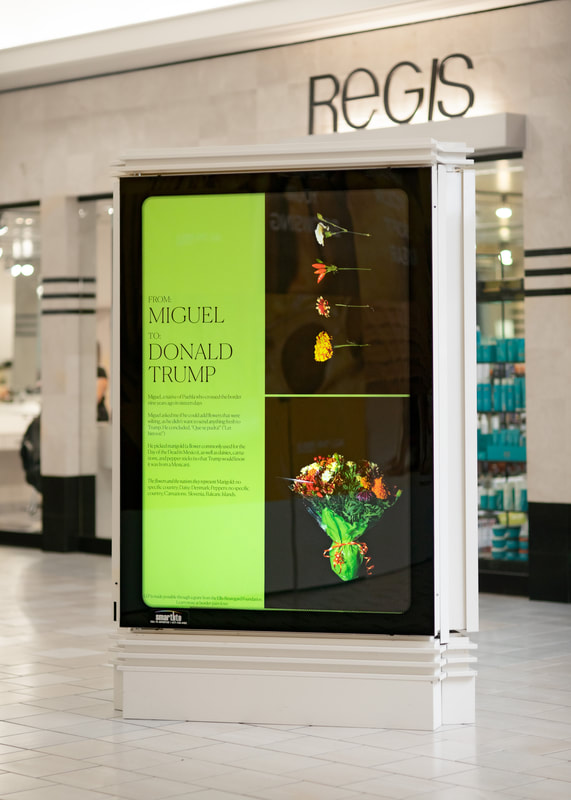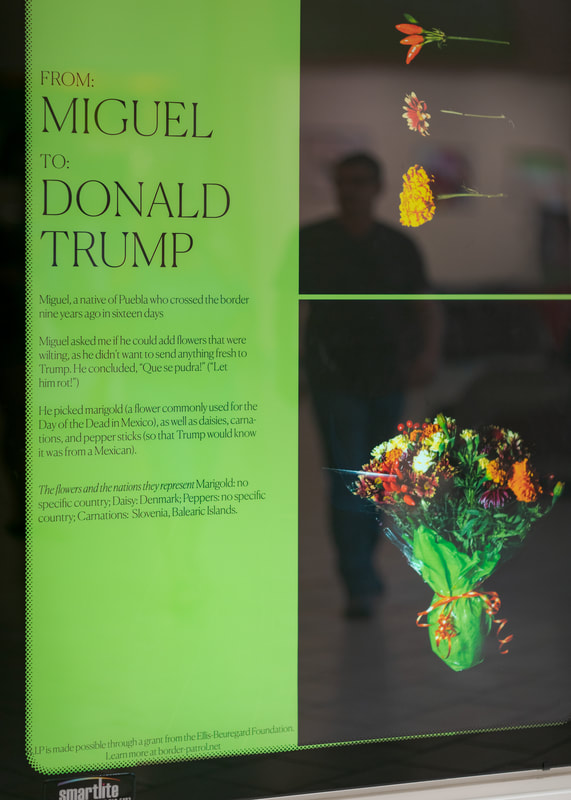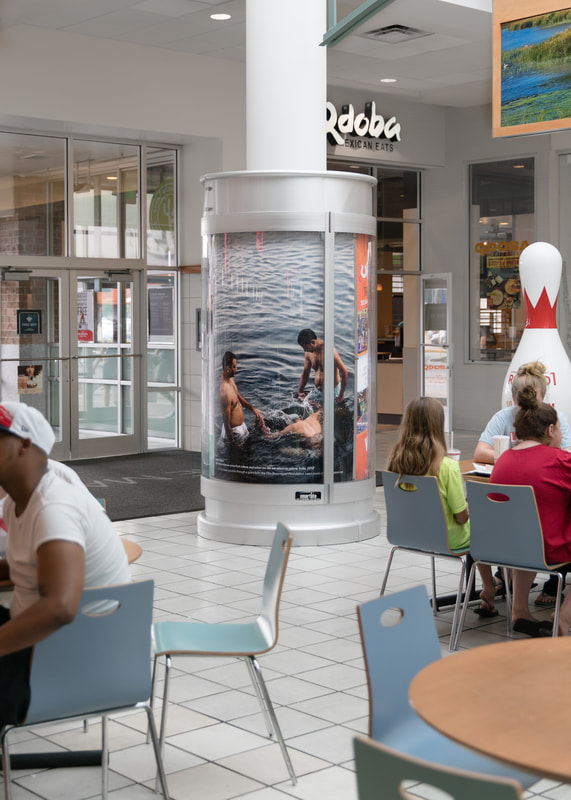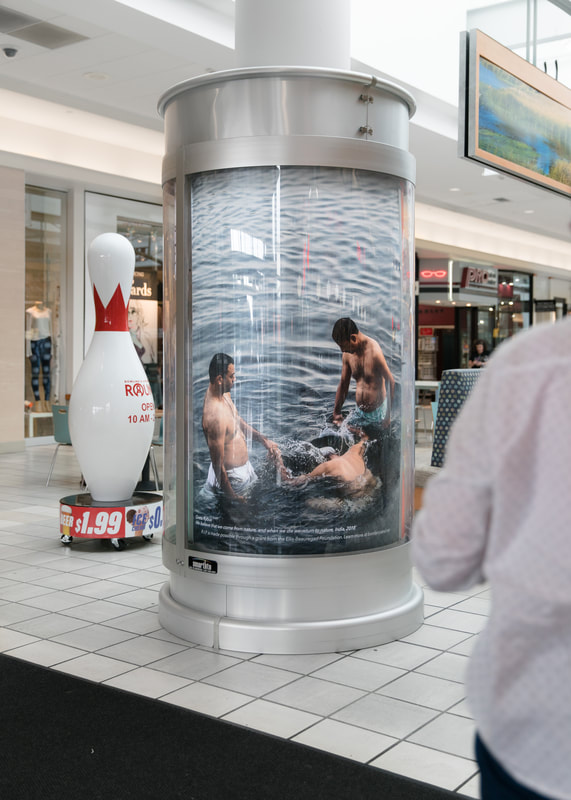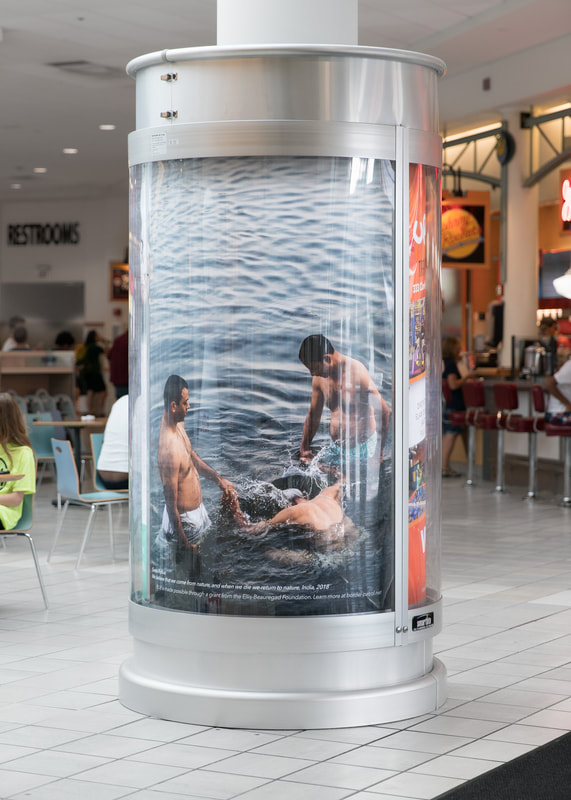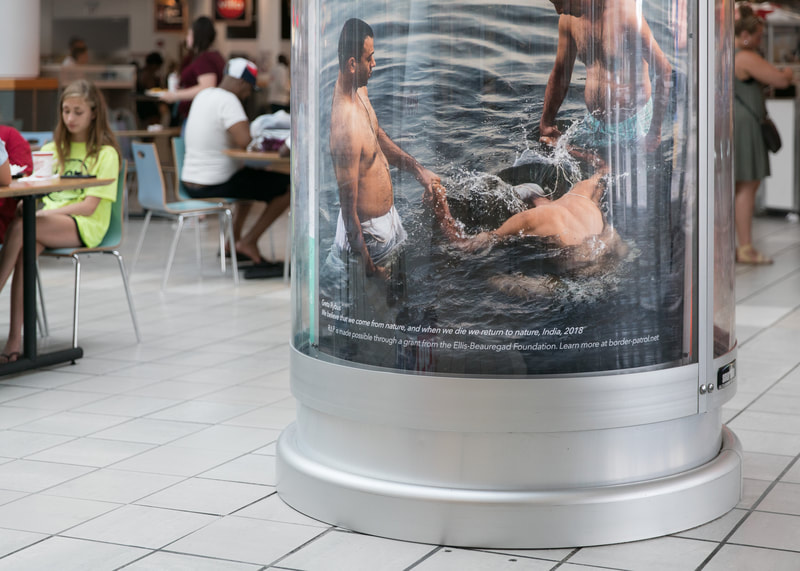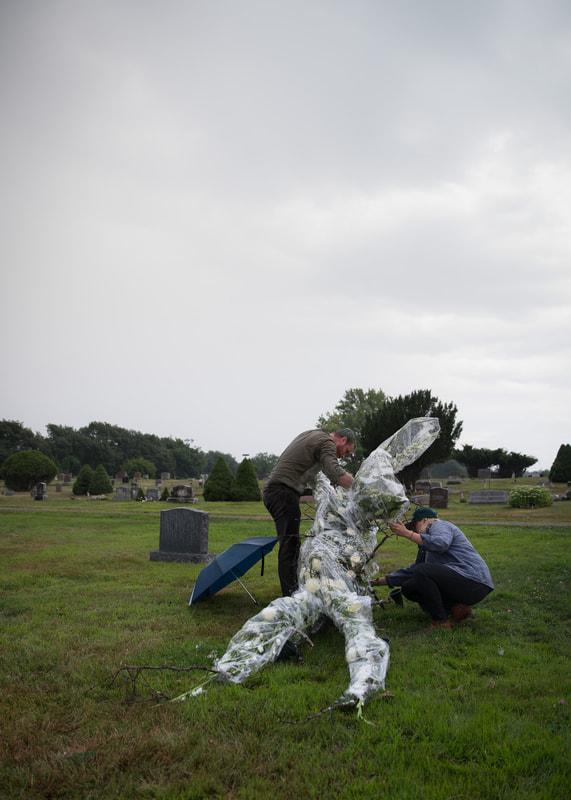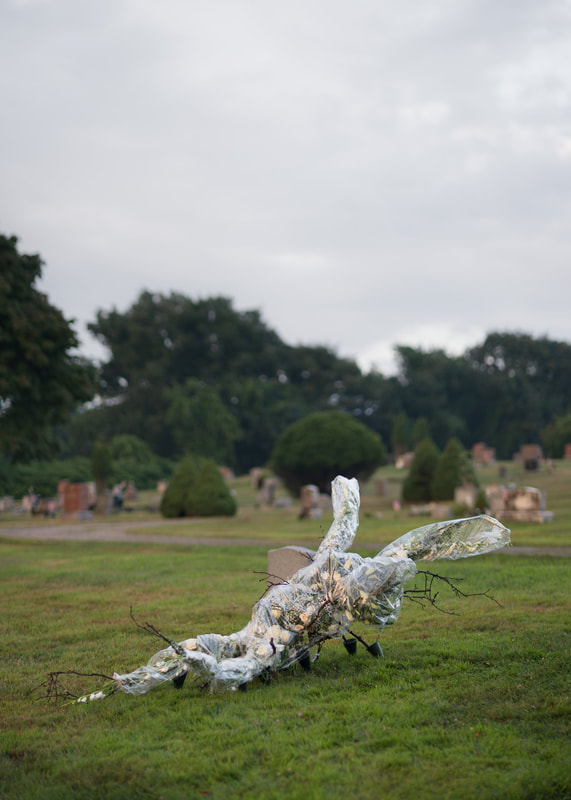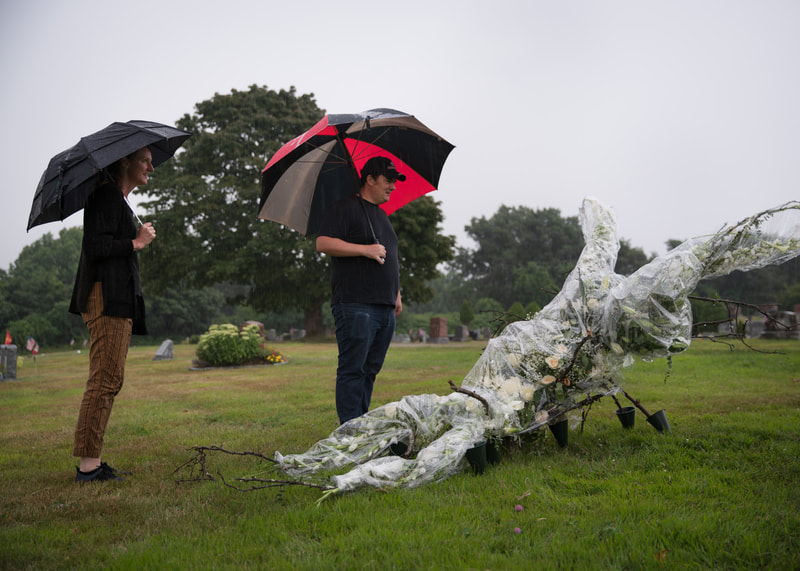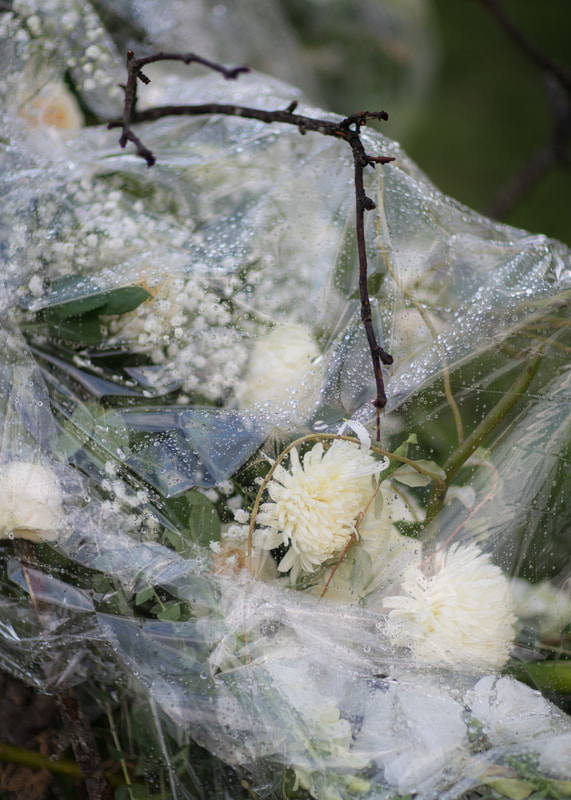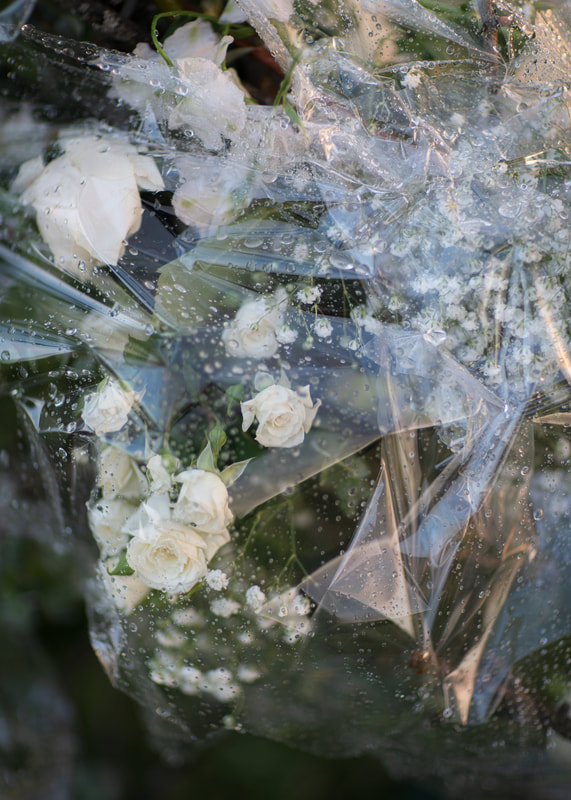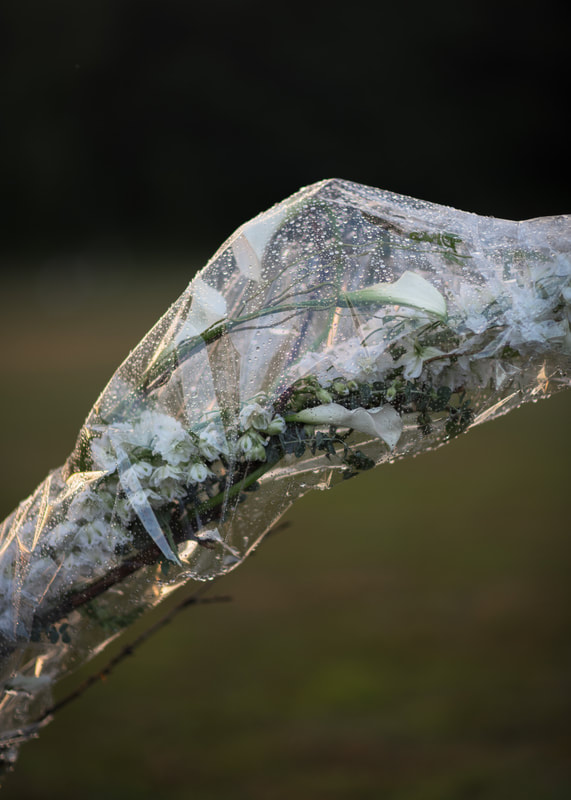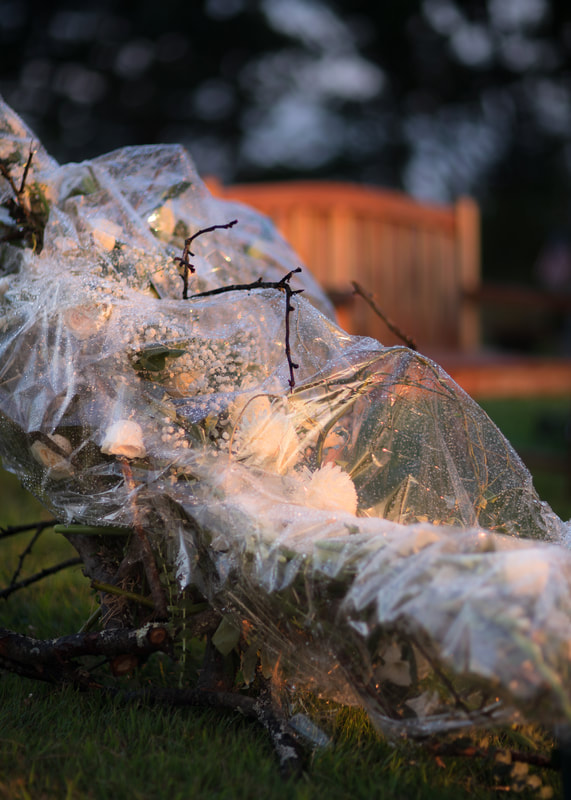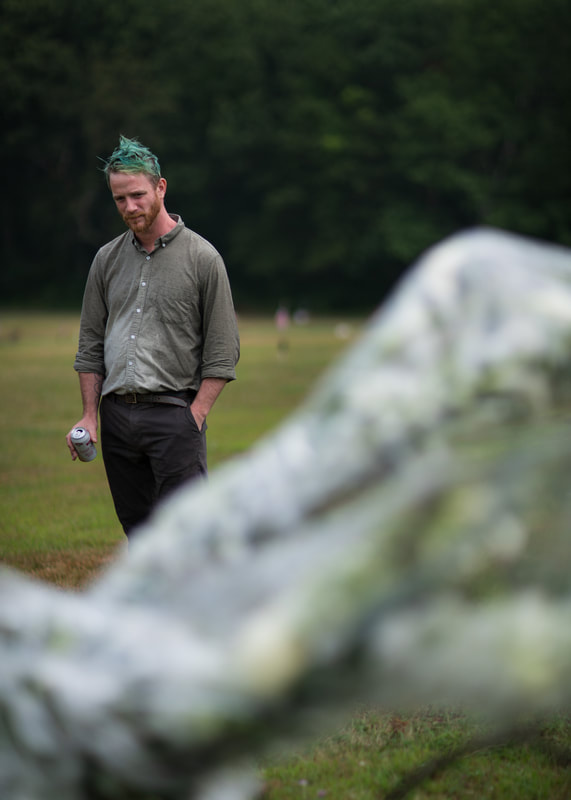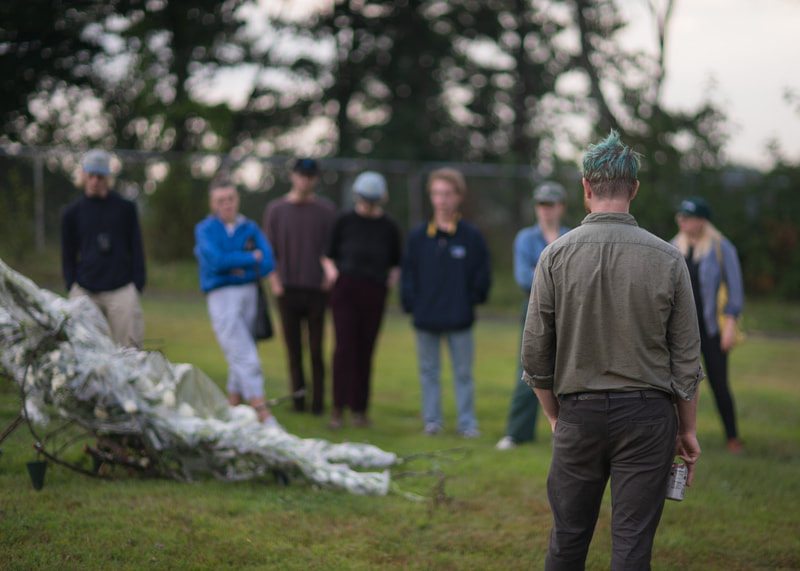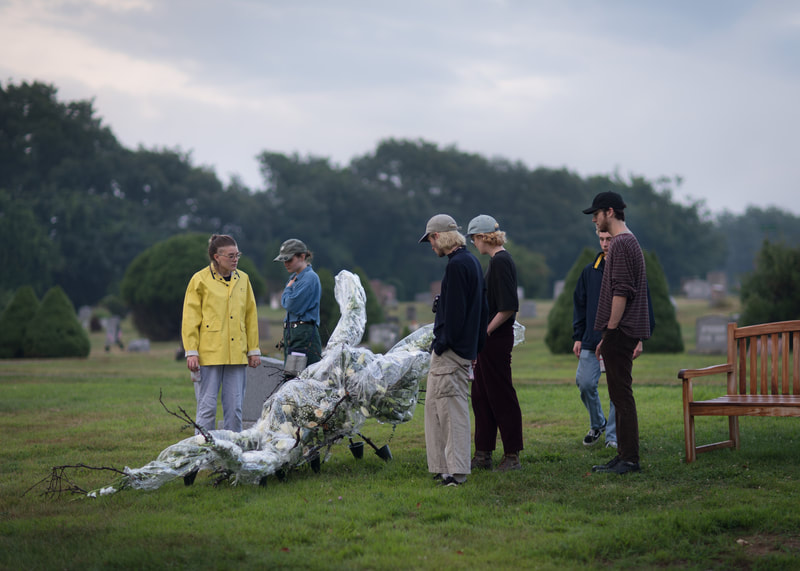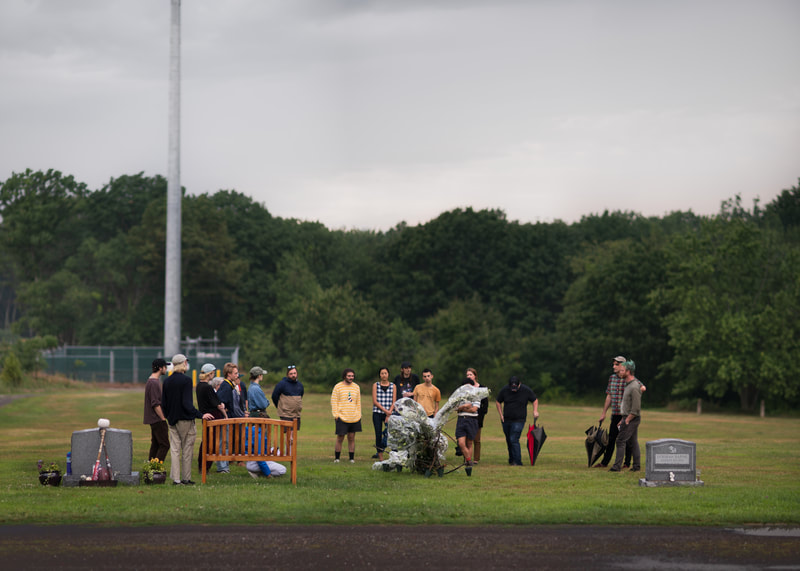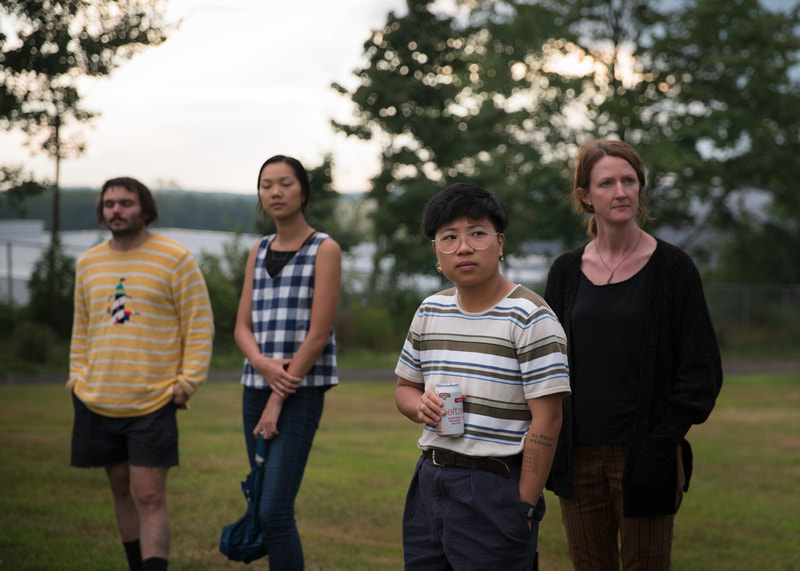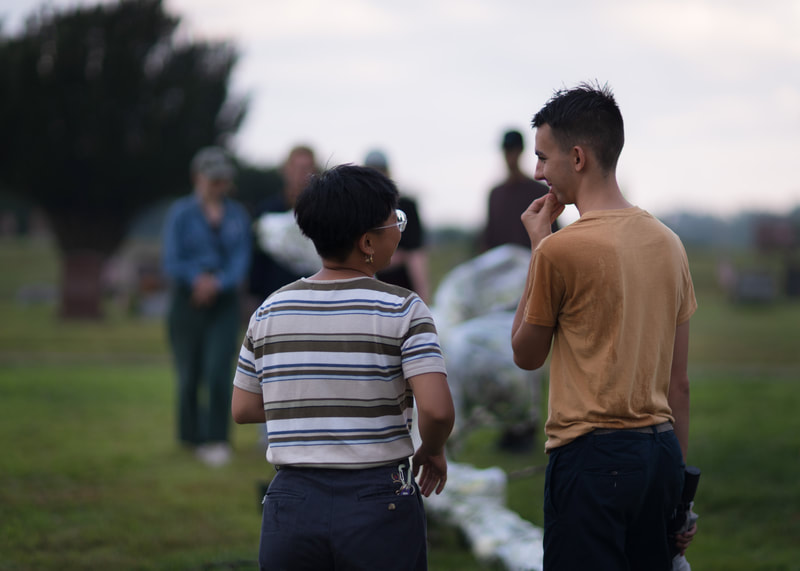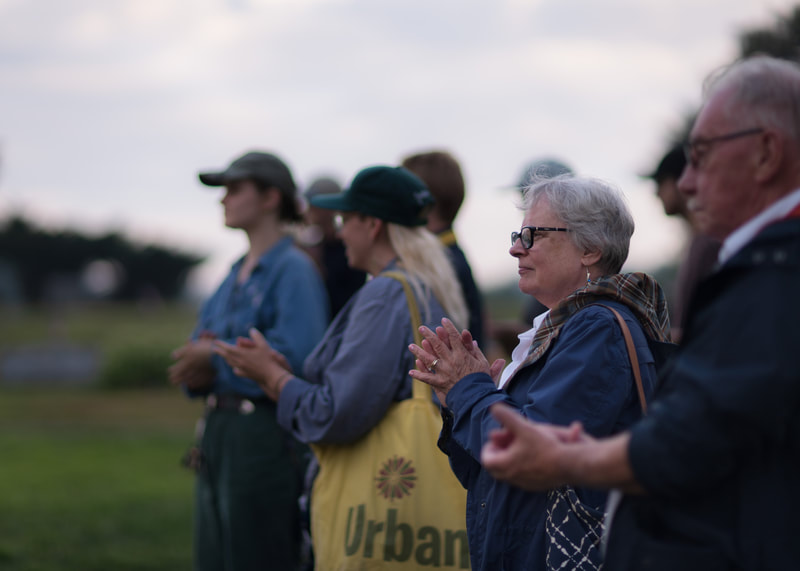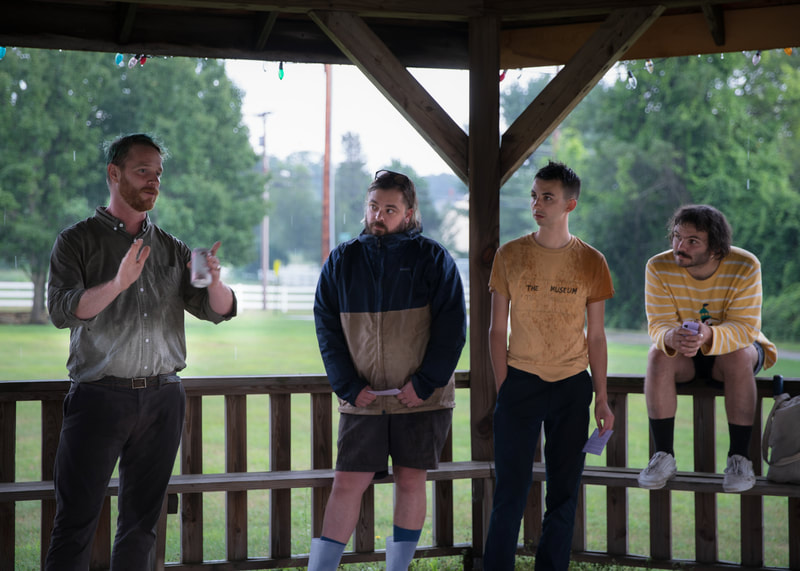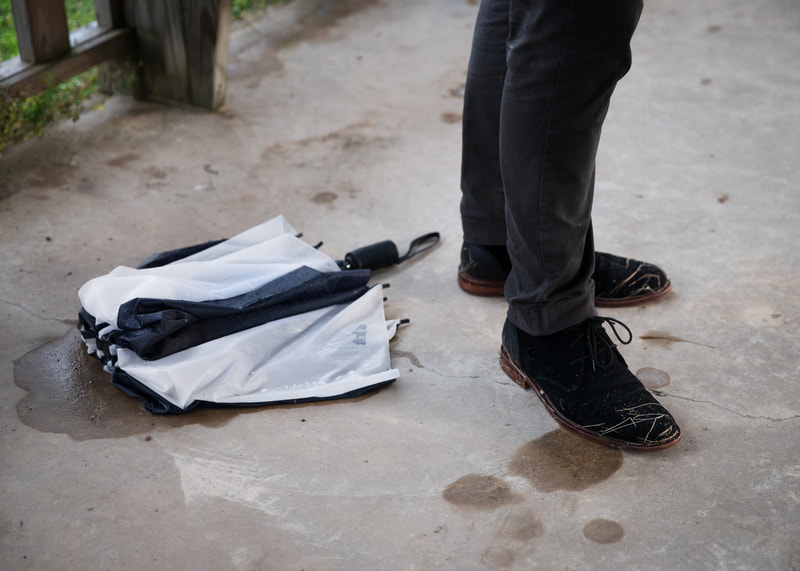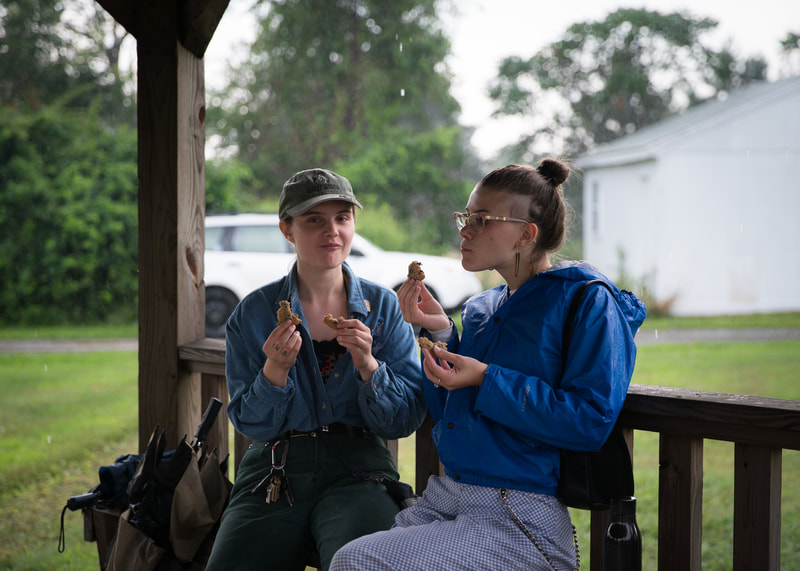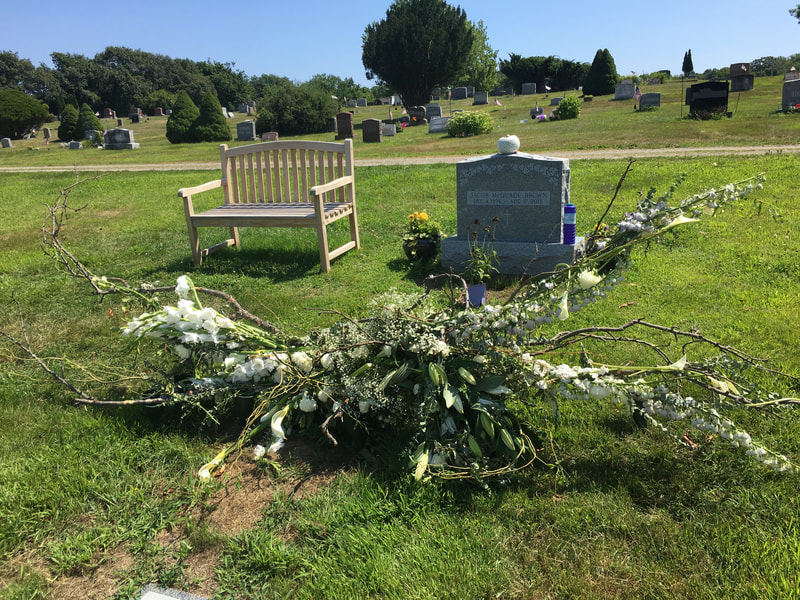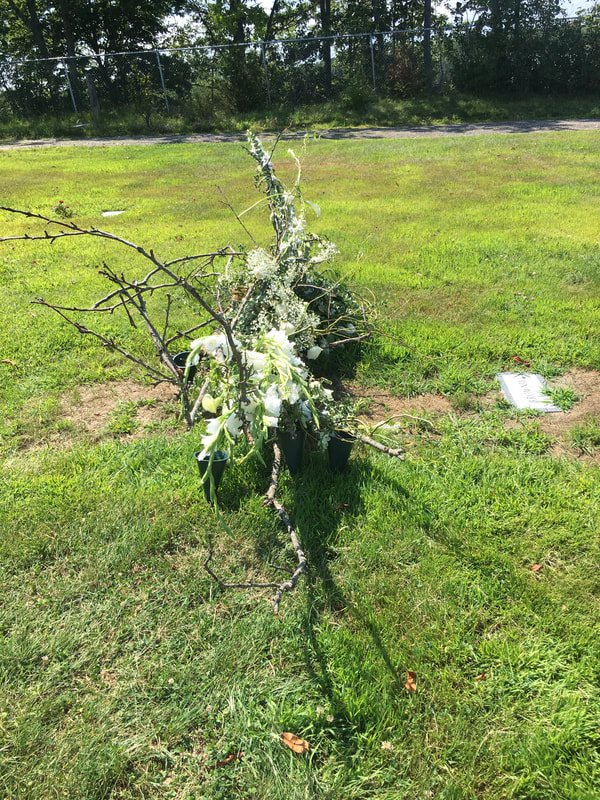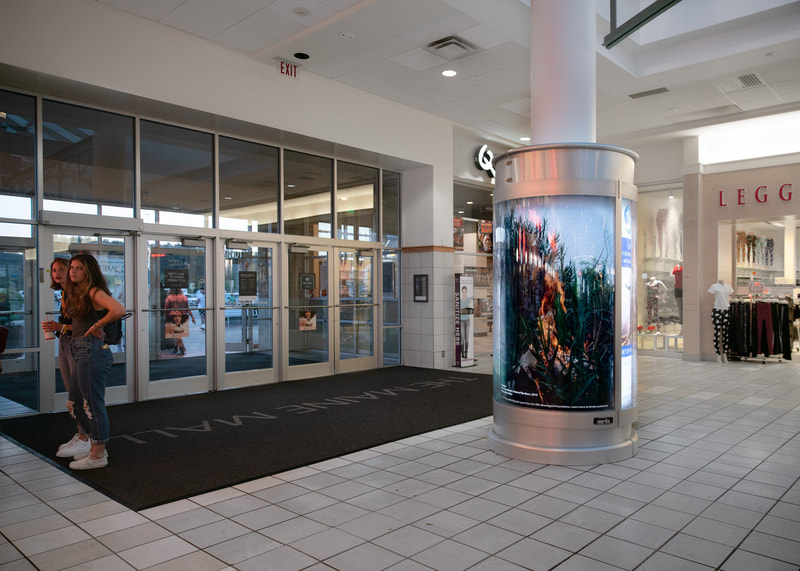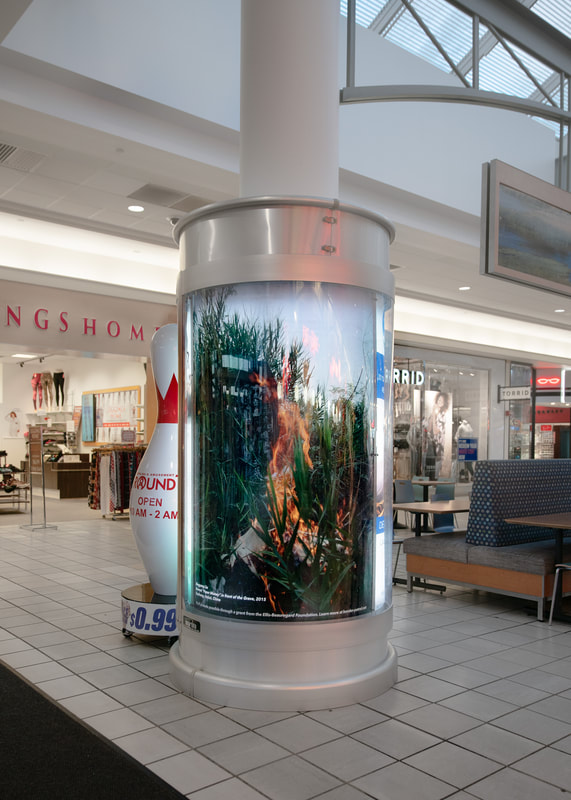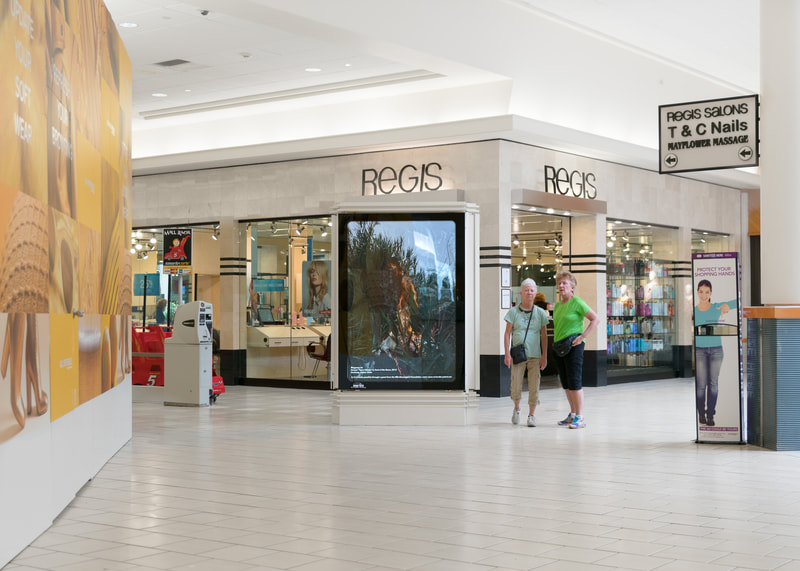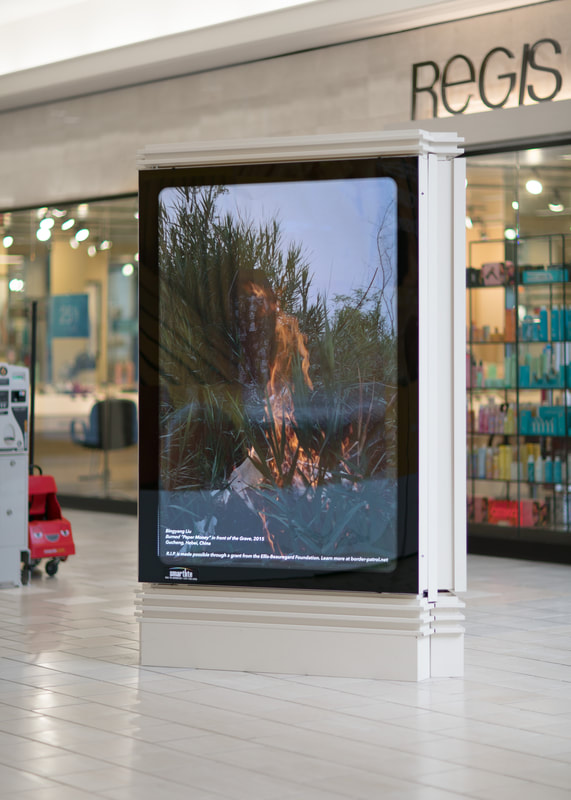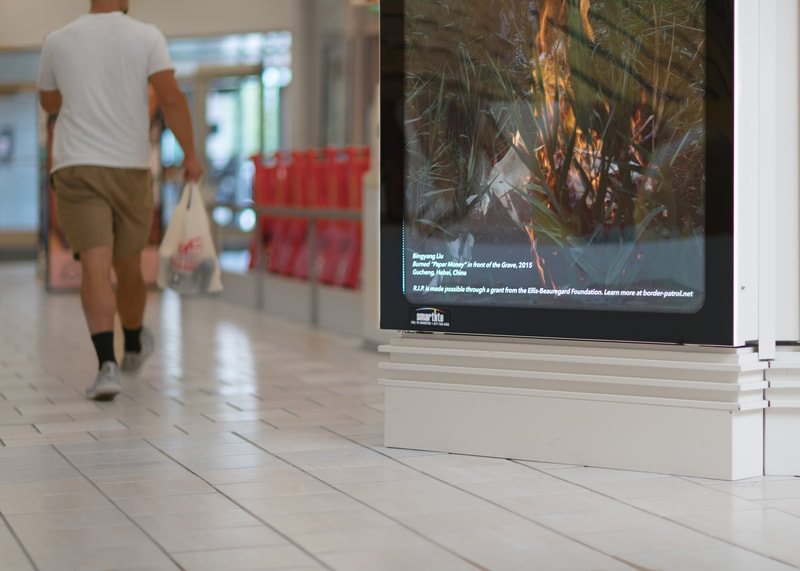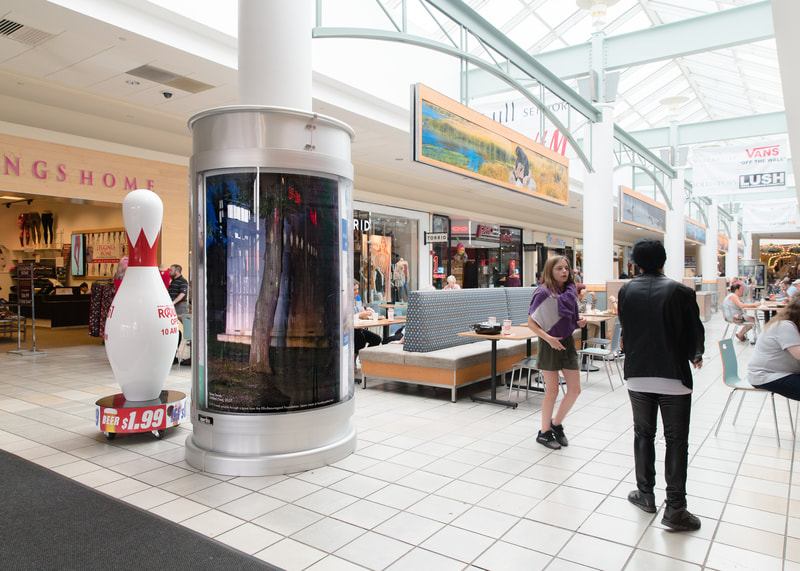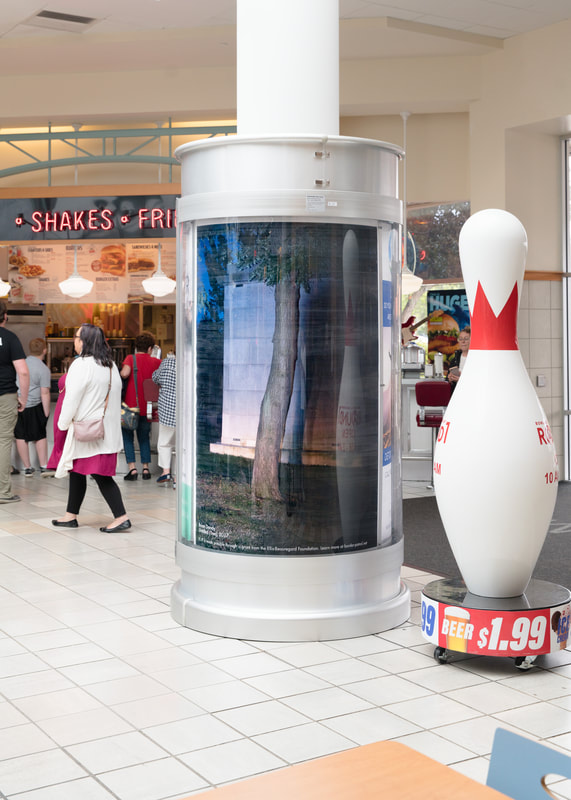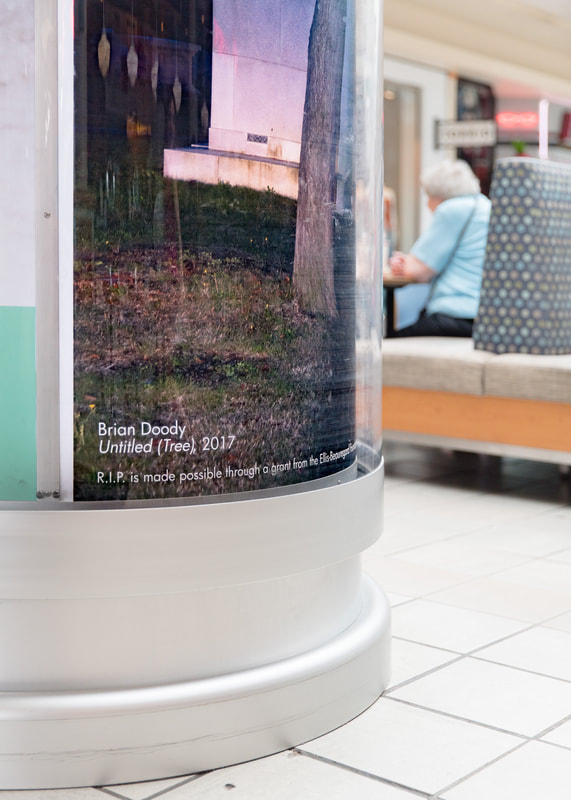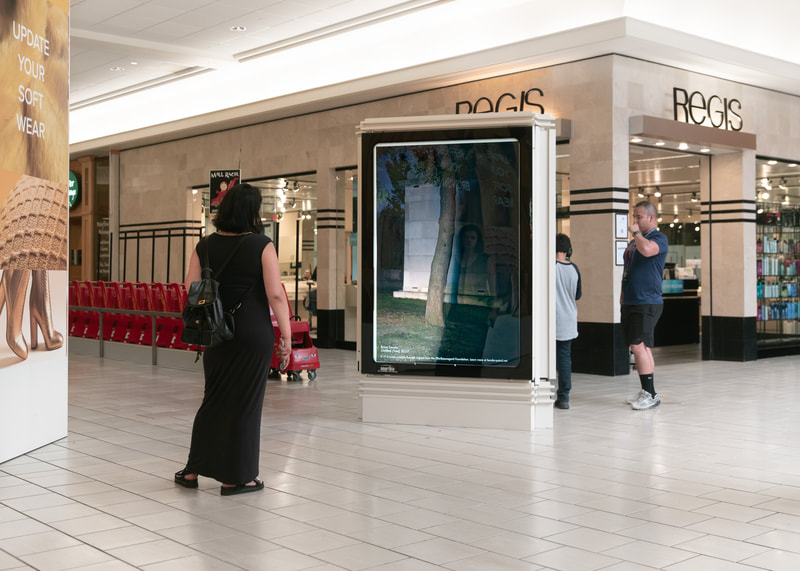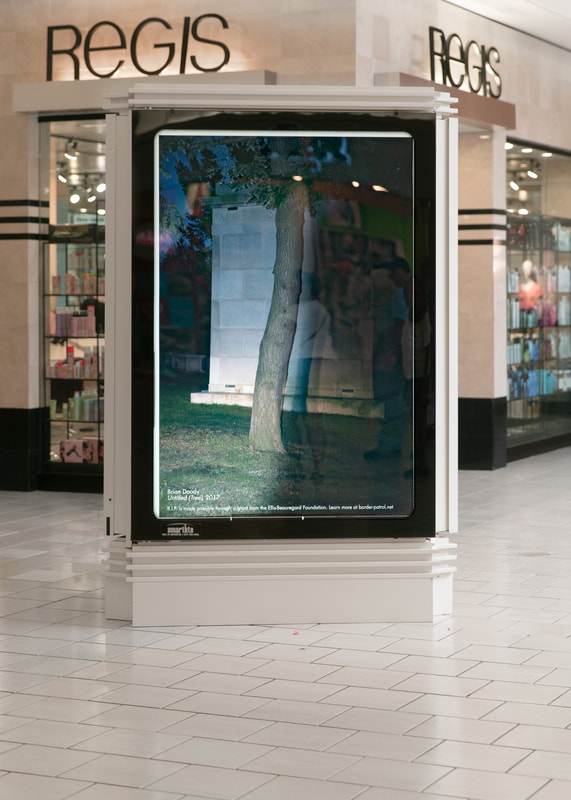R.I.P.
A 2019 public art initiative funded by the Ellis-Beauregard Foundation
Video by Joel Tusi
Border Patrol is pleased to announce the launch of R.I.P., a public art initiative addressing the politics and aesthetics of death.
Just as the collective used the architecture of its gallery's former home in the State Theatre building to inform each exhibition, Border Patrol will draw influence from the formal characteristics of the shopping mall and the cemetery for its newest public art initiative, R.I.P. Beginning June 1, Border Patrol will commission and exhibit a series of temporary and permanent works that will be on view at the Maine Mall and the Highland Memorial Cemetery through September 2019. All R.I.P. programs are free and open to the public.
R.I.P. makes use of the architectural and aesthetic cues within both contexts to address forms of death--ecological, economic, linguistic--within contemporary American society. Each month from June 1 - September 30, 2019, R.I.P. will present one photograph in an advertising display case in the the Maine Mall Food Court by artists Brian Doody (ME), Bingyang Liu (CA), Greta Rybus (ME), and Lizania Cruz (NY). The photographs collectively reference death and dying, landscape, and the role that photography plays in mourning rituals. Within the Highland Memorial Cemetery, the project will support floral sculptures by John Sundling (ME) and a participatory, movement-based work inspired by funerary processions and conceived by Vanessa Anspaugh (ME) and Asher Woodworth (ME). Both sites are places for community gatherings, collective rituals, and public memorials. As such, R.I.P. will culminate with a permanent monument in the Highland Memorial Cemetery. A tombstone with an excerpt of a poem by Imani Elizabeth Jackson (RI) hand carved by Isabel Kelley (ME) will be on view indefinitely. Please visit plot 1 in lot 15 in section 3 during normal cemetery viewing hours to visit the permanent memorial.
R.I.P. seeks to highlight relationships among art, extinction, loss, grief, death, advertising, ceremony, and private property. The mall and the cemetery share many cultural connotations and formal qualities that are essential to the narrative of R.I.P. The mall directory, with its vertical, slab-like structure anchored in its surroundings, can easily be read as an illuminated gravestone or memorial. Its role as a vehicle for advertising in the mall also calls attention to the ways in which capitalism relies upon continual obsolescence in the production of unfulfilled desires -- the death of retail space and emergence of dead malls across the country are two examples of this. In the cemetery, R.I.P. focuses on the materials that reinforce grieving aesthetics. Flowers allude to life’s ephemeral status, while stone addresses notions of legacy; both express a temporal framework that extend and contract the span of a human life. The cyclical financial crises, mass extinction events, and the historic weight of slavery are just some of the deaths that contemporary Americans face today. While we hope that our project allows participants to pose questions about the future, Border Patrol is interested in the ability of collective aesthetic rituals to excavate repressed or buried events/stories/facts/histories and hold space for healing to occur.
R.I.P. is made possible through a Ellis Beauregard Foundation Project Grant. You can follow the project on Instagram - @r_i_p_maine
Just as the collective used the architecture of its gallery's former home in the State Theatre building to inform each exhibition, Border Patrol will draw influence from the formal characteristics of the shopping mall and the cemetery for its newest public art initiative, R.I.P. Beginning June 1, Border Patrol will commission and exhibit a series of temporary and permanent works that will be on view at the Maine Mall and the Highland Memorial Cemetery through September 2019. All R.I.P. programs are free and open to the public.
R.I.P. makes use of the architectural and aesthetic cues within both contexts to address forms of death--ecological, economic, linguistic--within contemporary American society. Each month from June 1 - September 30, 2019, R.I.P. will present one photograph in an advertising display case in the the Maine Mall Food Court by artists Brian Doody (ME), Bingyang Liu (CA), Greta Rybus (ME), and Lizania Cruz (NY). The photographs collectively reference death and dying, landscape, and the role that photography plays in mourning rituals. Within the Highland Memorial Cemetery, the project will support floral sculptures by John Sundling (ME) and a participatory, movement-based work inspired by funerary processions and conceived by Vanessa Anspaugh (ME) and Asher Woodworth (ME). Both sites are places for community gatherings, collective rituals, and public memorials. As such, R.I.P. will culminate with a permanent monument in the Highland Memorial Cemetery. A tombstone with an excerpt of a poem by Imani Elizabeth Jackson (RI) hand carved by Isabel Kelley (ME) will be on view indefinitely. Please visit plot 1 in lot 15 in section 3 during normal cemetery viewing hours to visit the permanent memorial.
R.I.P. seeks to highlight relationships among art, extinction, loss, grief, death, advertising, ceremony, and private property. The mall and the cemetery share many cultural connotations and formal qualities that are essential to the narrative of R.I.P. The mall directory, with its vertical, slab-like structure anchored in its surroundings, can easily be read as an illuminated gravestone or memorial. Its role as a vehicle for advertising in the mall also calls attention to the ways in which capitalism relies upon continual obsolescence in the production of unfulfilled desires -- the death of retail space and emergence of dead malls across the country are two examples of this. In the cemetery, R.I.P. focuses on the materials that reinforce grieving aesthetics. Flowers allude to life’s ephemeral status, while stone addresses notions of legacy; both express a temporal framework that extend and contract the span of a human life. The cyclical financial crises, mass extinction events, and the historic weight of slavery are just some of the deaths that contemporary Americans face today. While we hope that our project allows participants to pose questions about the future, Border Patrol is interested in the ability of collective aesthetic rituals to excavate repressed or buried events/stories/facts/histories and hold space for healing to occur.
R.I.P. is made possible through a Ellis Beauregard Foundation Project Grant. You can follow the project on Instagram - @r_i_p_maine
R.I.P. presents Funeral for the Ocean
A performance by Vanessa Anspaugh & Asher Woodworth
September 28, 2019 in the Highland Memorial Cemetery
R.I.P presented Funeral for the Ocean, a public performance by Vanessa Anspaugh (ME) and Asher Woodworth (ME).
As the final installment of Border Patrol’s R.I.P. project, this duo facilitated an experiential, movement-based happening at Highland Memorial Cemetery. Ritualistic gestures and choreographies of memorial gratitude were felt and witnessed as participants used salt and water to mourn the sea together.
Vanessa Anspaugh is a choreographer and performance based artist born and raised in Los Angeles, CA and eventually New York, NY. Her work has been both commissioned and presented by Danspace Project, Dance Theater Workshop, New York Live Arts, The River to River Festival, BAX, The Sculpture Center, The Hessel Museum of Art, AUNTS, Movement Research, Catch Series,The Kitchen (through Emily Roysdon) Performance Mix at HERE Arts Center, Studio 303 in Montreal, as well as The Cowels Center in Minneapolis, for The Zenon Dance Company. She has had funded creative residencies through DTW Studio Series, Mount Tremper Arts, Kattsbaan International Dance Center, The Mac Dowell Colony, LMCC, BAX, BOFFO Fire Island Performance Residency, and The Bard College Fisher Center. In 2017 her work The End of Men, was a Bessie Award nominee in both the Outstanding Production and Best Sound Design (by Ryan MacDonald) categories. As a performer Anspaugh has worked for Aretha Aoki, Juliette Mapp, Robbinschilds, Faye Driscoll, Taylor Mac, Emily Johnson, Jen Rosenblit among others. She is currently at work on the latest development of her research with a new theatrical dance work titled, Aggression Confession.
Follow Vanessa on Instagram - @vanessaanspaugh
Asher Woodworth is a multidisciplinary artist based in Maine. Asher’s background is in performance, postmodern dance, and video. He works primarily with bodies and concepts, but also objects, plants, and heat. Recently Asher has worked with Dean Moss, Deborah Hay, and Hana van Der Kolk. He has shown his work at Movement Research, Danspace Project, SPACE Gallery, Boston Center for the Arts, and has led workshops and performed nationally and internationally at such venues as MoMA, The Walker Art Center, Diverseworks, BRIC, Kelly Strayhorn Theater, The Electric Lodge, CATI Dans, Body Actualized Center, and Uferstudios Berlin. He is the recipient of a 2015 Touring Grant from New England Foundation for the Arts. Asher holds a BA in Dance and Philosophy from Bennington College.
Follow Asher in Instagram - @aawashh
As the final installment of Border Patrol’s R.I.P. project, this duo facilitated an experiential, movement-based happening at Highland Memorial Cemetery. Ritualistic gestures and choreographies of memorial gratitude were felt and witnessed as participants used salt and water to mourn the sea together.
Vanessa Anspaugh is a choreographer and performance based artist born and raised in Los Angeles, CA and eventually New York, NY. Her work has been both commissioned and presented by Danspace Project, Dance Theater Workshop, New York Live Arts, The River to River Festival, BAX, The Sculpture Center, The Hessel Museum of Art, AUNTS, Movement Research, Catch Series,The Kitchen (through Emily Roysdon) Performance Mix at HERE Arts Center, Studio 303 in Montreal, as well as The Cowels Center in Minneapolis, for The Zenon Dance Company. She has had funded creative residencies through DTW Studio Series, Mount Tremper Arts, Kattsbaan International Dance Center, The Mac Dowell Colony, LMCC, BAX, BOFFO Fire Island Performance Residency, and The Bard College Fisher Center. In 2017 her work The End of Men, was a Bessie Award nominee in both the Outstanding Production and Best Sound Design (by Ryan MacDonald) categories. As a performer Anspaugh has worked for Aretha Aoki, Juliette Mapp, Robbinschilds, Faye Driscoll, Taylor Mac, Emily Johnson, Jen Rosenblit among others. She is currently at work on the latest development of her research with a new theatrical dance work titled, Aggression Confession.
Follow Vanessa on Instagram - @vanessaanspaugh
Asher Woodworth is a multidisciplinary artist based in Maine. Asher’s background is in performance, postmodern dance, and video. He works primarily with bodies and concepts, but also objects, plants, and heat. Recently Asher has worked with Dean Moss, Deborah Hay, and Hana van Der Kolk. He has shown his work at Movement Research, Danspace Project, SPACE Gallery, Boston Center for the Arts, and has led workshops and performed nationally and internationally at such venues as MoMA, The Walker Art Center, Diverseworks, BRIC, Kelly Strayhorn Theater, The Electric Lodge, CATI Dans, Body Actualized Center, and Uferstudios Berlin. He is the recipient of a 2015 Touring Grant from New England Foundation for the Arts. Asher holds a BA in Dance and Philosophy from Bennington College.
Follow Asher in Instagram - @aawashh
R.I.P. presents Imani Elizabeth Jackson
A Public Memorial
On view in the Highland Memorial Cemetery
R.I.P is pleased to present a permanent public memorial by poet, Imani Elizabeth Jackson (Providence, RI) on view indefinitely beginning Saturday, September 28th in the Highland Memorial Cemetery located in South Portland, Maine.
Jackson’s work is currently concerned with the twin horrors of the transatlantic slave trade and environmental destruction, grief, and the unclaimed/unclaimable things and people produced by these acts. Border Patrol commissioned the artist to write an original text. Stone artist Isabel Kelly (Portland, ME) carved the lines by hand on a tombstone that serves a public memorial. The stone was laid flush with the ground on the grave site, encouraging a dual reading of the work: on one hand it is a printing press that can reproduce the text endlessly and on the other, it is a durational performance in which the tombstone will eventually be swallowed by the earth as a kind of funerary offering. The text on the tombstone reads:
We are now living
We dead
Our breath still held
Our bodies are still
The only certainties, we living,
the rivers, the seas
Imani Elizabeth Jackson is an extradisciplinary poet from Chicago. Her writings appear in and are forthcoming from Triple Canopy, Apogee, the Arkansas International, midst, BOMB, Triquarterly, and elsewhere, and she is the author of the chapbook saltsitting (reissued by g l o s s, 2020) and the book Flag (forthcoming from Futurepoem). She collaborates with S*an D. Henry-Smith as mouthfeel; together they engage Black diasporic histories and culinary traditions through cooking, poetry, and ephemeral practices. With S*an, she co-created the artist book Consider the Tongue (printed by Antenna/Paper Machine, 2019). Imani has been in residence at F4F (2018), Antenna/Paper Machine (with S*an D. Henry-Smith, 2019), and ACRE (2019). She is the recipient of Futurepoem’s 2020 Other Futures Award and has also received the Arkansas International’s inaugural C.D. Wright Award, selected by Hanif Abdurraqib, as well as several awards from Brown University. Imani is also a member of the Poetry Project’s newsletter editorial collective and co-organizes the Chicago Art Book Fair. She lives in Rhode Island now, where she’s an MFA candidate at Brown.
Jackson’s work is currently concerned with the twin horrors of the transatlantic slave trade and environmental destruction, grief, and the unclaimed/unclaimable things and people produced by these acts. Border Patrol commissioned the artist to write an original text. Stone artist Isabel Kelly (Portland, ME) carved the lines by hand on a tombstone that serves a public memorial. The stone was laid flush with the ground on the grave site, encouraging a dual reading of the work: on one hand it is a printing press that can reproduce the text endlessly and on the other, it is a durational performance in which the tombstone will eventually be swallowed by the earth as a kind of funerary offering. The text on the tombstone reads:
We are now living
We dead
Our breath still held
Our bodies are still
The only certainties, we living,
the rivers, the seas
Imani Elizabeth Jackson is an extradisciplinary poet from Chicago. Her writings appear in and are forthcoming from Triple Canopy, Apogee, the Arkansas International, midst, BOMB, Triquarterly, and elsewhere, and she is the author of the chapbook saltsitting (reissued by g l o s s, 2020) and the book Flag (forthcoming from Futurepoem). She collaborates with S*an D. Henry-Smith as mouthfeel; together they engage Black diasporic histories and culinary traditions through cooking, poetry, and ephemeral practices. With S*an, she co-created the artist book Consider the Tongue (printed by Antenna/Paper Machine, 2019). Imani has been in residence at F4F (2018), Antenna/Paper Machine (with S*an D. Henry-Smith, 2019), and ACRE (2019). She is the recipient of Futurepoem’s 2020 Other Futures Award and has also received the Arkansas International’s inaugural C.D. Wright Award, selected by Hanif Abdurraqib, as well as several awards from Brown University. Imani is also a member of the Poetry Project’s newsletter editorial collective and co-organizes the Chicago Art Book Fair. She lives in Rhode Island now, where she’s an MFA candidate at Brown.
R.I.P. presents Lizania Cruz
Miguel to Donald Trump, ongoing
September 3 - September 5, 2019 in the Maine Mall Food Court
R.I.P is presented one photograph by New York City-based artist, Lizania Cruz in the Maine Mall food court . Miguel to Donald Trump is part of an ongoing series called Flowers for Immigration. The artist creates images that feature the personal stories of undocumented flower workers as told through their floral arrangements. The work was censored and removed by Maine Mall staff on Thursday, September 5th after being on view for only three days. The text in the image reads:
From: Miguel
To: Donald Trump
Miguel, a native of Puebla who crossed the border nine years ago in sixteen days.
Miguel asked me if he could add flowers that were wilting, as he didn't want to send anything fresh to Trump. He concluded, "Que se pudra!" ("Let him rot!")
He picked marigold (a flower commonly used for the Day of the Dead in Mexico), as well as daises, carnations, and pepper sticks (so that Trump would know it was from a Mexican).
The flowers and the nations they represent
Marigold: no specific country; Daisy: Denmark; Peppers: no specific country; Carnations: Solvenia, Balearic Islands.
From: Miguel
To: Donald Trump
Miguel, a native of Puebla who crossed the border nine years ago in sixteen days.
Miguel asked me if he could add flowers that were wilting, as he didn't want to send anything fresh to Trump. He concluded, "Que se pudra!" ("Let him rot!")
He picked marigold (a flower commonly used for the Day of the Dead in Mexico), as well as daises, carnations, and pepper sticks (so that Trump would know it was from a Mexican).
The flowers and the nations they represent
Marigold: no specific country; Daisy: Denmark; Peppers: no specific country; Carnations: Solvenia, Balearic Islands.
Lizania Cruz is a Dominican participatory artist, designer, and curator interested in how migration affects ways of being & belonging. Through research, oral history, and audience participation, she creates projects that highlight a pluralistic narrative on migration. Cruz has been an artist-in-residence and fellow at the Laundromat Project Create Change (2018-2019), Agora Collective Berlin (2018), Design Trust for Public Space (2018), and Recess Session (2019).
Follow Lizania on Instagram - @lizaniacruz
R.I.P. presents Greta Rybus
We believe we come from nature and when we die we return to nature, India, 2018
August 1 - September 30, 2019 in the Maine Mall Food Court
R.I.P is pleased to present a photograph by Maine artist, Greta Rybus during the month of August in the Maine Mall food court. The image on display is part of a collaboration with Kamalan Travels for Lodestars Anthology.
Greta Rybus is a full-time freelance photojournalist specializing in editorial portraiture, travel and documentary photography. She is currently based in Portland, Maine where she lives with her sweetheart and her scruffy sidekick, a dog named Murray.
Born in Boise, Idaho, Greta studied Photojournalism and Cultural Anthropology at the University of Montana. Her first book, Handcrafted Maine, about people in Maine working with art land, and sea, is now in bookstores. She has a goal to spend one month of every year living and photographing in a new place and is currently working on an ongoing project exploring how climate change impacts individuals and communities. Thus far, she has worked on the project in Senegal, Panama, Norway, and Idaho. She has lived in Japan, the Netherlands, the San Juan Islands, Montana, Seattle, the Sawtooth Mountains, and Berlin, Germany.
Greta Rybus is a full-time freelance photojournalist specializing in editorial portraiture, travel and documentary photography. She is currently based in Portland, Maine where she lives with her sweetheart and her scruffy sidekick, a dog named Murray.
Born in Boise, Idaho, Greta studied Photojournalism and Cultural Anthropology at the University of Montana. Her first book, Handcrafted Maine, about people in Maine working with art land, and sea, is now in bookstores. She has a goal to spend one month of every year living and photographing in a new place and is currently working on an ongoing project exploring how climate change impacts individuals and communities. Thus far, she has worked on the project in Senegal, Panama, Norway, and Idaho. She has lived in Japan, the Netherlands, the San Juan Islands, Montana, Seattle, the Sawtooth Mountains, and Berlin, Germany.
R.I.P. presents John Sundling
Untitled (floral sculpture), 2019
August 13 - 15, 2019 in Highland Memorial Cemetery
R.I.P. commissioned John Sundling (Portland, ME) to make a botanical-based sculpture on our grave site in the Highland Memorial Cemetery, which was unveiled on Tuesday, August 13th.
John's work explores the intersection of floriography, ritual, death, and environmentalism. The piece was designed to droop & decay over one week, dying for its audience and constantly changing as it began to turn back into dirt. Nodding to the role that flowers play in contemporary funerary rites, the untitled sculpture invited audiences to consider the role that preservation plays above and below ground.
"Flowers and Death are intrinsically linked," Sundling writes. "We kill flowers because they are so beautiful yet keep them artificially alive afterwards. These living dead things are then asked to communicate unspeakable emotions for us, often as a the deceased lays nearby. The body and the flowers are both pumped full of preservatives and kept in controlled environments to help create the illusion of life while decay sets in. Neither are alive nor quite gone yet, existing in a place between realms. The return to ashes and dust delayed by formaldehyde, acid, and bleach."
On Thursday, August 15, an unknown person or group removed the cellophane wrappings from the flower installation and reassembled the piece on an adjacent grave site. In accordance with the artist's wishes, the work was removed from public view that evening , just two days after its unveiling. Instead of having the piece slowly decay over the course of a week through natural processes, human intervention ushered in an abrupt end. We asked John if he would like to craft a statement addressing the issue. His response is below:
“Today I decided that it was time to consign this sculptural installation to the ash bin a number of days early. This morning the piece was partially dismantled and moved by the grounds crew to be used for a memorial service at the cemetery. As a professional florist I do understand why people thought this was the right move (it was covered in white flowers after all), but I wasn't creating this as a memorial in a traditional sense and don't see the move as respectful to my work or the grieving family having this thrust upon them. Though in some ways I see this reuse as in-line with the life cycle of the piece, ultimately it no longer reflects my thoughts and goals for this project in its current state.”
John Sundling is an artist, designer & builder living in Portland, Maine. He runs Plant Office, a houseplant store and design studio that specializes in flowers and live events. He also dabbles in public art, theatrical design, and installations. His work has recently taken him to Alaska, Virginia, New York, Massachusetts, Ireland, and across the great state of Maine.
Follow John on Instagram - @plant.office
John's work explores the intersection of floriography, ritual, death, and environmentalism. The piece was designed to droop & decay over one week, dying for its audience and constantly changing as it began to turn back into dirt. Nodding to the role that flowers play in contemporary funerary rites, the untitled sculpture invited audiences to consider the role that preservation plays above and below ground.
"Flowers and Death are intrinsically linked," Sundling writes. "We kill flowers because they are so beautiful yet keep them artificially alive afterwards. These living dead things are then asked to communicate unspeakable emotions for us, often as a the deceased lays nearby. The body and the flowers are both pumped full of preservatives and kept in controlled environments to help create the illusion of life while decay sets in. Neither are alive nor quite gone yet, existing in a place between realms. The return to ashes and dust delayed by formaldehyde, acid, and bleach."
On Thursday, August 15, an unknown person or group removed the cellophane wrappings from the flower installation and reassembled the piece on an adjacent grave site. In accordance with the artist's wishes, the work was removed from public view that evening , just two days after its unveiling. Instead of having the piece slowly decay over the course of a week through natural processes, human intervention ushered in an abrupt end. We asked John if he would like to craft a statement addressing the issue. His response is below:
“Today I decided that it was time to consign this sculptural installation to the ash bin a number of days early. This morning the piece was partially dismantled and moved by the grounds crew to be used for a memorial service at the cemetery. As a professional florist I do understand why people thought this was the right move (it was covered in white flowers after all), but I wasn't creating this as a memorial in a traditional sense and don't see the move as respectful to my work or the grieving family having this thrust upon them. Though in some ways I see this reuse as in-line with the life cycle of the piece, ultimately it no longer reflects my thoughts and goals for this project in its current state.”
John Sundling is an artist, designer & builder living in Portland, Maine. He runs Plant Office, a houseplant store and design studio that specializes in flowers and live events. He also dabbles in public art, theatrical design, and installations. His work has recently taken him to Alaska, Virginia, New York, Massachusetts, Ireland, and across the great state of Maine.
Follow John on Instagram - @plant.office
R.I.P. presents Bingyang Liu
Burned "Paper Money" in front of the Grave, 2015
July 1 - July 31, 2019 in the Maine Mall Food Court
R.I.P is pleased to present one photograph by Bingyang Liu, an artist based in California and China. Bingyang Liu's work considers social relationship under contemporary status through photography, often engaging with ancient art and ancient culture as part of long-term projects. Follow Bingyang on Instagram - @brianliu2008
R.I.P. presents Brian Doody
Untitled (Tree), 2017
June 1 - June 30, 2019 in the Maine Mall Food Court
R.I.P launched with a photograph from Maine-based artist, Brian Doody in the Maine Mall Food Court.
Brian Doody is an artist currently living in Portland, ME. Their work has been published in the form of zines and book throughout the years, as well as appeared in numerous publications and group shows. They are the recipient of a 2017 Kindling Fund Grant and will be a resident at Hewnoaks Artist Colony come August 2019.
Brian’s past work explored themes of working class, technology, online presence, queer communities, and relationships of people. Brian’s current work continues to explore identity, with a deeper look into food insecurity, earth decay, bodies, and grief. With an exploration into traumatic social structures, childhood fantasy realms, and death, the artist hopes to uplift and support the people and places that are often left in the dark.
Brian Doody is an artist currently living in Portland, ME. Their work has been published in the form of zines and book throughout the years, as well as appeared in numerous publications and group shows. They are the recipient of a 2017 Kindling Fund Grant and will be a resident at Hewnoaks Artist Colony come August 2019.
Brian’s past work explored themes of working class, technology, online presence, queer communities, and relationships of people. Brian’s current work continues to explore identity, with a deeper look into food insecurity, earth decay, bodies, and grief. With an exploration into traumatic social structures, childhood fantasy realms, and death, the artist hopes to uplift and support the people and places that are often left in the dark.
